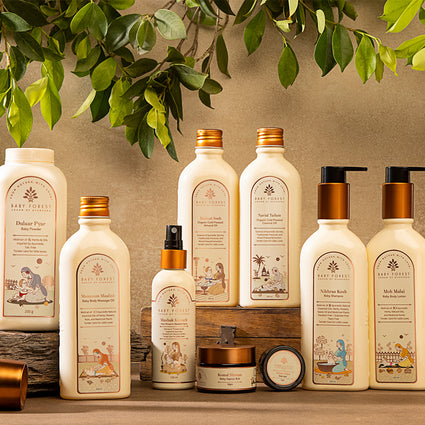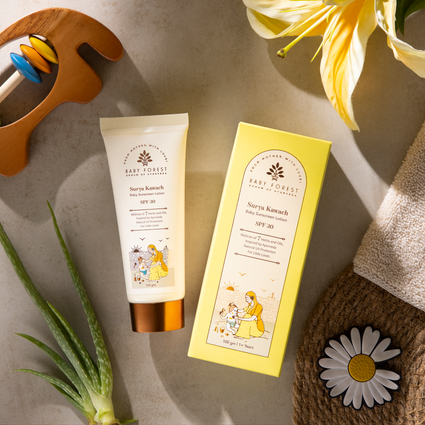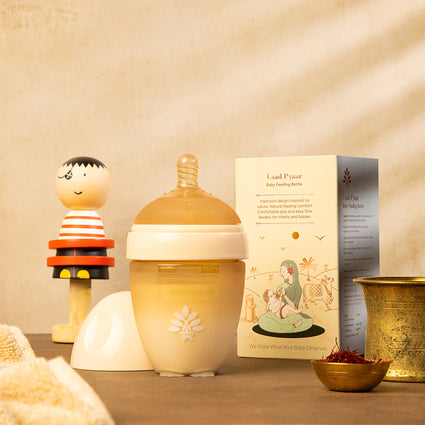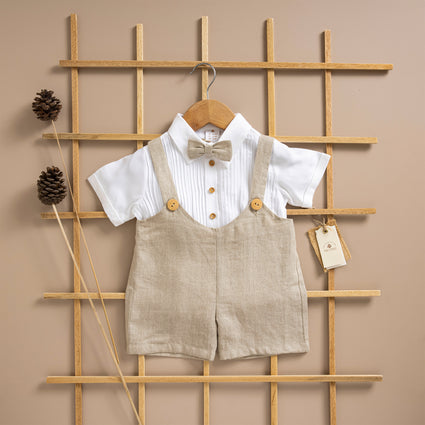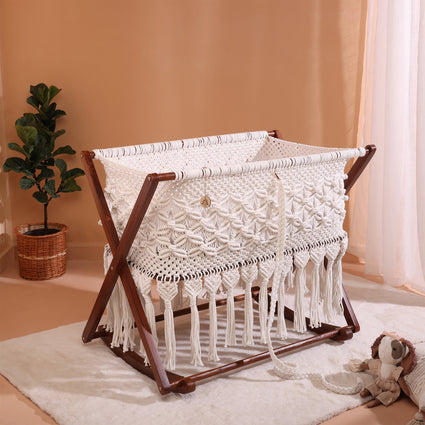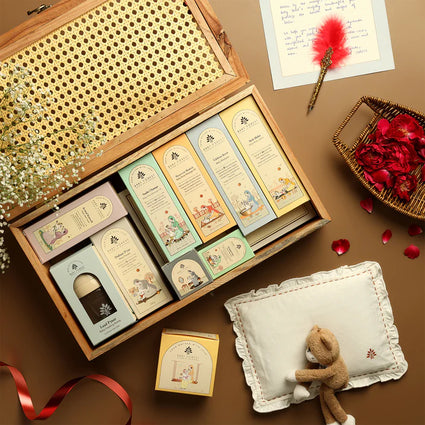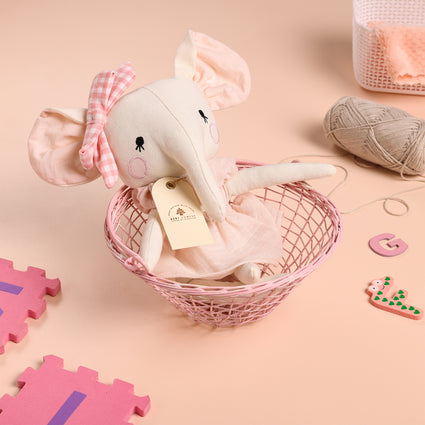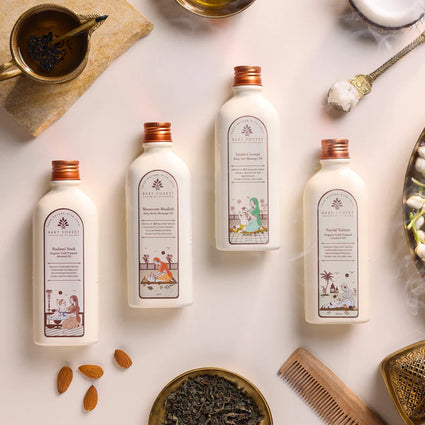Baby Care & Parenting Blogs
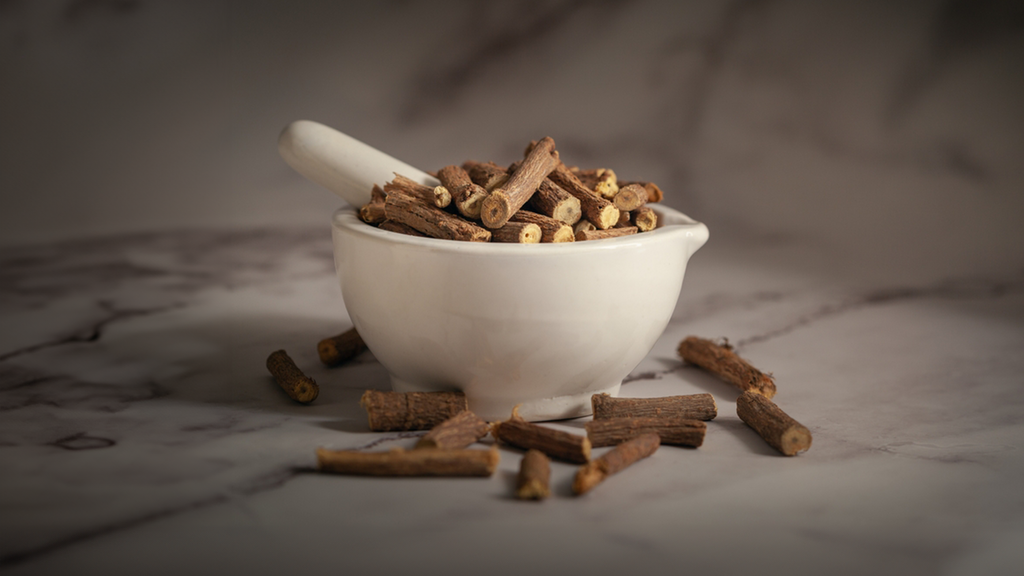
Secrets of Licorice: Ancient Remedy or Modern Superfood?
Parenting is a journey of continuous learning, blending tradition with modern care. Licorice, known as mulethi in India, is a natural herb valued for its soothing, antimicrobial, and anti-inflammatory properties. Exploring the Secrets of Licorice reveals how it can enhance your baby’s daily care with gentle, natural benefits—like using Organic Licorice for purity or Licorice Root Sticks for traditional wellness.
What is Licorice?
Licorice is a beloved herb, prized for its naturally sweet taste, soothing qualities, and healing potential. The Secrets of Licorice reveal themselves in its long-standing use in herbal remedies, where its anti-inflammatory and antimicrobial properties shine, supporting wellness in gentle, effective ways. Whether it’s Real Black Licorice, offering an authentic, robust essence, or Organic Licorice, delivering a pure and clean touch, this herb adapts to countless needs. Beyond its role in baby care—like calming irritated skin or easing mild congestion—it extends into broader traditions, bridging ancient wisdom with modern parenting. From vapor rubs to teething aids, licorice proves its versatility, providing a natural boost to daily routines. Its sweet charm and protective benefits make it a standout choice for nurturing little ones, ensuring comfort without harsh chemicals—a perfect blend of nature’s best for today’s caregivers seeking reliable, time-tested solutions.

Benefits of Licorice in Baby Care Products
Licorice has become a cornerstone in baby care, delivering gentle nourishment and protection that parents can trust—picture it as the Best Licorice for your tiny tot. Unlocking the Secrets of Licorice unveils its remarkable benefits, making it a standout ingredient in products designed for little ones. This herb’s natural properties soothe and shield, offering a safe, effective way to care for delicate skin and beyond. From calming irritations to providing a protective barrier, licorice proves its worth in everyday routines. Its gentle touch ensures babies stay comfortable without harsh chemicals, blending tradition with modern care seamlessly. Whether in creams, rubs, or cleansers, licorice enhances the nurturing experience, showing why it’s a go-to choice for thoughtful parenting today.
-
Gentle on Delicate Skin
Licorice brings its anti-inflammatory magic to baby care, easing redness and irritation with a soft, calming effect—perfect for diaper rash creams and soothing treatments. The Secrets of Licorice spotlight how it comforts sensitive skin, offering a gentler approach than something like Cinnamon Licorice might imply with its bolder profile. This herb works wonders on tender areas, reducing discomfort without overwhelming delicate systems. Parents can rely on its natural properties to keep their baby’s skin smooth and irritation-free, especially during those fussy moments. Unlike harsher options, licorice provides a nurturing touch that aligns with the needs of little ones, making it a staple in gentle care routines that prioritize safety and comfort above all.
-
Protection Against Bacteria
Licorice’s antimicrobial strength steps up in baby care, guarding fragile skin against harmful bacteria with ease. It shines in vapor rubs, soothing mild colds and congestion—a subtle treasure within the Secrets of Licorice, far from the intense flavor of Chocolate Licorice, which isn’t suited for babies. This herb acts as a natural shield, keeping infections at bay while offering relief during stuffy nights. Its protective qualities extend beyond the surface, ensuring your little one stays healthy and comfortable. Safe and gentle, licorice in these products provides peace of mind for parents, blending efficacy with nature’s care. It’s a quiet hero in maintaining baby wellness without relying on synthetic additives.
-
Natural Cleanser in Baby Products
Infused in shampoos and soaps, licorice keeps baby skin soft and tackles issues like cradle cap with a tender touch. The Secrets of Licorice reveal its knack for gentle cleansing, surpassing flavored varieties like Strawberry Licorice that don’t fit baby-safe formulas. This herb cleans without stripping natural oils, leaving skin smooth and nurtured—a perfect ally for daily baths. Its soothing nature ensures even the most sensitive scalps stay calm, making it a parent’s friend in maintaining hygiene naturally. Licorice stands out for its ability to care gently, avoiding the harshness other cleansers might bring, and keeps your baby’s skin in top shape with ease. -
A Healthy Sweetener
Licorice offers a natural sweetness that safely replaces refined sugar in teething products, easing the baby’s discomfort with care. This lesser-known perk among the Secrets of Licorice makes it ideal for little ones, not like Chocolate Licorice, crafted for adult indulgence. Its mild flavor comforts without overloading tiny systems, providing a gentle alternative in soothing gels. Parents can trust this herb to deliver sweetness that’s safe and effective, steering clear of artificial additives. Licorice’s role here highlights its versatility, ensuring teething moments are less stressful and more natural, keeping your baby happy and healthy with every use. -
A Natural Mosquito Repellent
Licorice powers mosquito repellents and patches, creating a soft yet strong shield against insects for your baby. The Secrets of Licorice extend to this natural defense, with Real Black Licorice extract boosting its strength beyond flavors like Cinnamon Licorice or Strawberry Licorice. This herb keeps bites at bay without harsh chemicals, offering a gentle barrier that’s safe for delicate skin. It’s a smart, natural way to protect your little one outdoors, blending efficacy with care. Licorice proves its worth here, giving parents a worry-free option to keep their baby comfortable and bite-free every day.
How to Use Licorice Safely
Using licorice safely unlocks more of its Secrets of Licorice for your baby’s care:
- Patch Test: Always test a small amount—like a dab of Black Licorice-infused cream—on your baby’s skin to check for reactions.
- Choose Baby-Specific Products: Use products formulated for babies to ensure the right concentration, avoiding strong types like Black Licorice.
- Follow Label Instructions: Stick to the recommended usage to avoid overexposure with this Best Licorice.
- Consult Your Pediatrician: Before introducing new products, seek medical advice for your baby’s safety, especially with unique options like Licorice Root Sticks.
Conclusion
Licorice is a gentle yet effective ingredient in baby care, offering soothing and protective benefits. By understanding the Secrets of Licorice, you can opt for baby-friendly formulations and consult your doctor before introducing new products to ensure the best care for your little one.

The Ultimate Baby Bathing Checklist for Your Baby's First...
Bringing your newborn home is a magical and joyous moment, but it also comes with a list of responsibilities, one of which is your baby's first bath. Bathing newborns is one of the things that many new parents worry about. We are familiar with the emotion. Even the most composed person can become anxious when bathing a newborn for the first time!
Fret not! We've crafted the ultimate baby bath essentials checklist to ensure that this special moment is not only stress-free but also a memorable bonding experience between you and your bundle of joy.
Bath time is a great chance for you and your baby to bond. It's also a great way to just relax and have fun.
Creating the Base for a Successful Baby Bathing Experience

-
Gather Your Supplies
Gather all the essential items for your baby bath products ahead of time – collect baby oil, gentle baby soap, a soft washcloth, baby shampoo, baby lotion, and a comfortable hooded towel. This practice will help you avoid the need to leave the baby unattended during the bath to search for these essential items.
-
Choose the Right Time
The timing is entirely in your hands, but it's recommended to choose a moment when you have the luxury of time and won't feel rushed. Aim to give your newborn baby's first bath within a week of birth, steering clear immediately after feeding or when they're overly tired.
Babies are often more alert in the morning, making it a favourable time for some parents. Alternatively, others may prefer scheduling the baby's first bath in the early evening as part of the bedtime routine. During the wind-down process, consider incorporating the bath into a calming sequence that includes a final bottle or nursing session, reading a book, and a gentle lullaby.
-
Maintain a Comfortable Room Temperature
Babies are sensitive to temperature changes, so ensure that the room is comfortably warm. A chilly environment can make the baby uneasy, while a hot room may lead to overheating.
How to Give a Newborn First Bath?
-
Pre-Bath Preparations:
Begin by organizing all the baby bath essentials within arm's reach. This prevents you from scrambling for supplies while holding a slippery baby. Lay out a soft towel on a flat, secure surface, such as a changing table, and keep diapers and clothes nearby for a swift post-bath routine.
-
Fill the Tub with Warm Water
Babies lose body heat rapidly, especially when undressed, so it's crucial to ensure the bathwater is at a comfortable temperature. Fill the baby bathtub with about 2 to 3 inches of warm water, ensuring it's not too hot. You can test the water temperature with your elbow or a bath thermometer; it should be around 37°C (98.6°F).
-
Undress the Baby
Gently undress your baby, cradling their head and neck with one hand. It's advisable to keep the baby's head above water and support their neck and back throughout the bath.
-
Gently Clean the Baby
Using a soft washcloth, gently cleanse the baby's face without soap. For the rest of the body, use a small amount of natural baby bath products. Pay special attention to skin folds, such as the neck, armpits, and diaper area. Be cautious around the umbilical cord stump; keep it dry and clean until it falls off naturally.
-
Rinse and Dry
After washing, gently pour clean, warm water over the baby's body to rinse off any soap. Once the bath is complete, promptly wrap the baby in a soft, hooded towel to keep them warm. Pat the skin dry, ensuring all creases are moisture-free to prevent irritation.
-
Post-Bath Care
Apply a gentle baby lotion to keep the skin moisturized. Dress the baby in a clean diaper and comfortable clothing. Remember, the first few baths should be brief—about 5 to 10 minutes—to prevent the baby from getting too cold.
Additional Tips for a Smooth Baby Bathing Experience
-
Stay Calm and Confident
Your baby can sense your emotions. Maintaining a calm demeanour will help your baby feel secure during their newborn baby's first bath.
-
Safety First
Never leave your baby unattended during bath time. If you need to step away, wrap the baby in a towel and take them with you.
-
Make It Enjoyable
Sing or talk to your baby during the bath to make the experience pleasant and engaging.
For parents searching for the best baby bath products in India, choosing natural baby bath products is a wonderful way to prioritize your baby's delicate skin. With the right baby bath essentials, you'll master how to give a newborn your first bath in no time!
Bathtime is a delightful experience for both babies and their new parents. Even if your little one appears less than thrilled initially, keeping the event short and sweet can make a world of difference. Before you know it, the sound of running water will have your baby squealing with joy. After the bath, remember to dry your baby gently with a soft towel and add a touch of Moh Malai Baby Body Lotion for an extra dose of post-bath comfort.

How to Soothe Your Newborn's Hiccups
Welcoming a newborn into the world is such a joyful yet sometimes overwhelming experience. As parents, we all want to do everything we can to ensure our little one's comfort and well-being. One thing that might leave you scratching your head, though, is those hiccups in newborn babies.
At first, they might seem alarming, but don't worry-hiccups are usually harmless. Still, they can be frustrating for you and your baby. In this article, we will explore why babies get hiccups, how to soothe them, and what to avoid, so you can confidently handle this common situation.
Why Do Newborns Get Hiccups?
Hiccups in newborn babies are pretty common, so there's no need to panic when it happens. But why do they occur? Simply put, hiccups happen when the diaphragm-the muscle just below the lungs-contracts involuntarily. This sudden contraction causes the classic "hic" sound. Babies are often triggered by swallowing air while feeding, having a full stomach, or even a slight temperature change. These little hiccups are totally normal and part of your baby's development. While they can feel unsettling, they're usually nothing to worry about.
Are Hiccups Harmful to Babies?
Many parents wonder if hiccups in newborn babies are harmful, and the short answer is no-they're not. Hiccups don't usually cause pain or distress for most babies. In fact, they often go away on their own after just a few minutes. Your baby's body is still adjusting to the world outside the womb, and hiccups are just part of that process. While they can sometimes be a little annoying, they're generally a temporary phase. However, if the hiccups bother your baby a lot or last for an unusually long time, it's always a good idea to check in with your pediatrician.
Tips to Soothe Your Baby's Hiccups
As a parent, you'll want to soothe your baby as quickly as possible when those pesky hiccups in newborn strike. Here are some simple and effective tips to help manage them:
-
Try Feeding Your Baby:
Sometimes, the act of sucking can help relax the diaphragm and stop the hiccups. Offer your baby a small amount of milk or water (depending on their age) and let them feed slowly. This can often calm the spasms. -
Burp Your Baby:
If your baby has hiccups, trapped air in their stomach might be the culprit. After feeding, gently burp them to release any trapped air. This can often prevent or stop the hiccups altogether. -
Change Positions:
If your baby's hiccups persist, try changing their position. Hold them upright for a while after feeding to let gravity help. Alternatively, rocking them gently or placing them in a different position may help ease the discomfort. -
Use a Pacifier:
Offering a pacifier can sometimes provide relief from hiccups in newborns. The sucking motion can help relax the diaphragm and stop the hiccups in their tracks.
-
Give Your Baby a Warm Bath:
A warm bath can help your baby relax and may provide some relief from hiccups. The warmth can soothe their muscles and help them feel more comfortable.
These tips can help you ease your baby's hiccups quickly so you both can get back to enjoying some peaceful moments together.
What to Avoid When Dealing with Baby Hiccups
While there are plenty of ways to soothe hiccups in newborn babies, there are also a few things you'll want to avoid. First, never try to startle your baby to stop their hiccups. It might seem like a quick fix, but it can actually upset them, and it won't solve the problem. Second, steer clear of giving your baby water or any solid food if they're too young.
Babies under six months should only have breast milk or formula, as other liquids can mess with their digestive system. And lastly, avoid overfeeding your baby. Sometimes, hiccups in newborn babies are caused by overeating, so smaller, more frequent feedings are usually the way to go. Keep these tips in mind, and you'll help your baby feel more comfortable!
Preventing Hiccups in the Future
While you can't always prevent hiccups in newborn babies from happening, there are a few simple strategies to help reduce the chances of them occurring:
-
Feed Your Baby Slowly:
Let your baby take their time during feedings. If they're feeding too quickly, they might swallow air, which can lead to hiccups. Taking small breaks during the feeding can help them pace themselves. -
Burp Frequently:
Burp your baby every few minutes during the feeding. This helps release any air trapped in their stomach, which can cut down on the likelihood of hiccups. -
Keep Baby Upright After Feedings:
After feeding, try holding your baby upright for at least 20 minutes. This can aid digestion and help prevent hiccups. -
Avoid Overfeeding:
It's tempting to let your baby feed as long as they want, but overfeeding can increase the chances of hiccups. Stick to their feeding schedule and avoid pushing them to finish more than they need.
These simple tips can help make hiccups in newborn babies less frequent, giving you and your baby a little more peace of mind.
When to Consult a Doctor?
In most cases, hiccups in newborn babies aren't something to worry about. However, if your baby's hiccups seem to last a long time or cause them discomfort, it's a good idea to reach out to your pediatrician. If the hiccups go on for more than an hour or happen frequently throughout the day, it could be a sign of something like acid reflux or another digestive issue. Always trust your instincts-if something doesn't feel right, don't hesitate to call your baby's doctor. It's better to be safe and get some peace of mind.
Conclusion
Dealing with hiccups in newborn babies can definitely be a little frustrating, especially when you're already juggling the many challenges of new parenthood. But remember, hiccups are totally common and usually harmless. In most cases, they'll go away on their own without you needing to do much. By following a few simple tips-like feeding slowly, burping your baby, and trying different positions-you can help soothe your little one and make those hiccups a bit easier to handle. And of course, if you're ever worried, don't hesitate to reach out to your pediatrician. Parenthood is all about learning as you go, and you're doing great!

What to Do When Your Baby's Tummy is Upset
As a new parent, feeling overwhelmed when your little one’s tummy isn’t feeling right is normal. A baby’s stomach can be pretty sensitive, and dealing with diarrhea in babies can be downright stressful. You might wonder, ‘Is this normal?’ or ‘Do I need to call the doctor?’ But don’t worry – you’re not alone in this, and with the correct info and a few helpful tips, you can quickly get your baby feeling better.
In this article, we’ll walk you through how to recognize diarrhea in babies, its common causes, what to do when it happens, and when it’s time to reach out to your paediatrician. We’ll also share some tips on how to help prevent future tummy troubles. So, let’s get started!
Recognising Diarrhea in Babies
The first thing you’ll want to do when your baby’s tummy is upset is figure out if it’s diarrhea. It’s normal for babies to have all sorts of different bowel movements, especially in those first few months. If your baby’s stool seems unusually watery, has a strong, unpleasant smell, or they’re going through several diaper changes in a short period, it’s probably Diarrhea. It’s important to keep track of these signs because, sometimes, Diarrhea can lead to dehydration or other health concerns. So, pay attention to how your baby’s feeling, and don’t hesitate to reach out if something feels off.
Common Causes of Diarrhea in Babies
Diarrhea in babies can happen for several reasons, and some causes are more common than others. Knowing what could be causing the issue helps you know how to respond and when to seek help. Here are some of the most common causes of Diarrhea in babies:
Viral Infections:
One of the most frequent causes of Diarrhea in babies is a viral infection, like rotavirus or norovirus. These infections often come with other symptoms, like a fever, vomiting, and general fussiness. It can be tough for your little one, but don’t worry – these infections usually clear up within a few days with lots of fluids and TLC.
Bacterial Infections:
Bacterial infections are a bit less common but can still happen. Things like contaminated food or water can cause bacterial gastroenteritis, which may lead to Diarrhea. Sometimes, this can be a bit more severe, so it’s always good to contact the doctor if you notice anything like this.
Teething:
Believe it or not, teething can sometimes lead to mild Diarrhea. Babies chewing on everything in sight produce more saliva, which can lead to looser stools. If your baby has no other symptoms and the Diarrhea is mild, it might be the teething work process.
Dietary Changes:
Introducing solid foods or switching formulas can sometimes upset your baby’s tummy, leading to Diarrhea. This is especially common when you’re adding new foods to your diet. To make things easier for their stomach, try introducing one food at a time and checking for any signs of tummy trouble.
Antibiotics:
If your baby has been prescribed antibiotics, Diarrhea could be a side effect. Antibiotics can mess with the balance of bacteria in your baby’s gut, leading to some digestive upset. If the Diarrhea is mild and your baby seems otherwise okay, it should pass once the course of antibiotics is finished.
Allergies or Intolerances:
Some babies may be sensitive or even allergic to certain foods, like dairy or gluten. If your baby gets Diarrhea after eating certain foods, it might be worth looking into potential food allergies or intolerances. If you suspect this could be the case, talk to your paediatrician to explore the possibility.
Understanding these causes can help you determine what might be happening and what steps to take to help your baby feel better!
What to Do When Your Baby Has Diarrhea?
Seeing your baby go through Diarrhea can be tough, but there are things you can do to help them feel better and get back on track. Here are a few simple steps to keep in mind:
Stay Hydrated:
The most important thing when your baby has Diarrhea is to ensure they stay hydrated. Diarrhea can cause dehydration pretty quickly, especially in babies. Keep offering small sips of water, breast milk, or formula throughout the day. If your baby is older, you can try oral rehydration solutions (ORS), which help replace the fluids and electrolytes your baby has lost.
Keep Baby Comfortable:
Diarrhea can make your baby’s bottom sore, so it’s essential to change their diaper often to prevent diaper rash. Be sure to use soft, gentle wipes (organic is always a good option), and don’t forget to apply a barrier cream to protect your delicate skin. Let your baby’s bottom air out as much as possible—this can help!
Stick to Simple Foods:
If your baby is eating solids, keep things simple and easy on their tummy. Think applesauce, bananas, rice, and toast—these bland foods are gentle on the stomach. Avoid fatty, spicy, or sugary foods, as they can worsen Diarrhea.
Offer Smaller, More Frequent Feedings:
If you’re breastfeeding, continue offering breast milk regularly. Smaller, more frequent feedings are fine and may help settle your baby’s tummy. If you’re formula-feeding, consider giving smaller bottles more often to avoid overloading your baby’s stomach at once.
Keep Baby Calm and Rested:
Diarrhea can make babies cranky and uncomfortable, so it’s important to give them plenty of opportunities to rest. Comfort your baby with soothing words, cuddles, and calm moments. Sometimes, a little extra love and relaxation is all they need to feel better.
With these simple steps, you can help your little one feel more comfortable while their tummy returns to normal!
When to Call the Doctor?
In most cases, Diarrhea in babies will resolve on its own within a few days. But there are times when you should reach out to your paediatrician to ensure everything is okay and rule out anything serious.
Here are some situations when it’s important to call the doctor:
- Your baby is under six months old and has Diarrhea.
- If your baby’s stool contains blood or mucus, it’s best to have it checked out. This could indicate a more serious issue.
- Your baby shows signs of dehydration:
- Your baby has a fever above 100.4°F (38°C) and Diarrhea.
- The Diarrhea lasts for more than 2-3 days.
- Your baby is extremely fussy, lethargic, or vomiting frequently.
Your paediatrician will be able to figure out what’s going on, if there’s an underlying cause, and provide treatment options to help your little one feel better. It’s always better to be safe and get professional advice when in doubt!
Preventing Future Episodes
While you can’t always prevent Diarrhea in babies, there are a few steps you can take to help reduce the risk. Here’s how:
Handwashing:
One of the simplest ways to keep your baby safe from infections is by keeping their hands clean. Make sure to wash your baby’s hands before meals, and don’t forget to wash your hands after changing diapers or handling food. This helps cut down on germs and reduces the risk of stomach bugs.
Introduce Foods Gradually:
When it’s time to introduce solids, take it slow. Try adding one new food at a time and wait a few days to see how your baby reacts. This makes spotting any food allergies or sensitivities that could upset their tummy easier.
Breastfeeding:
If you’re able to, keep breastfeeding as long as you can. Breast milk is packed with nutrients and antibodies that support your baby’s immune system and help digestion. It’s one of the best ways to protect your little one from tummy troubles.
Use Organic Baby Products:
Choosing organic baby products like gentle wipes, lotions, and even organic baby food can make a big difference. These products are often free from harsh chemicals and additives, which help protect your baby’s sensitive skin and digestive system. Organic options are a great way to make your baby’s tummy and skin happy.
Conclusion
Having a baby with an upset tummy can definitely be tough, but with the right knowledge and a little care, you’ll be able to help them feel better and even prevent future issues. By recognizing the signs of Diarrhea in babies, understanding what might be causing it, and knowing when to call the doctor, you’ll feel more confident handling these situations.
Just remember to keep your baby hydrated, comfortable, and well-rested, and don’t hesitate to reach out to the doctor if something feels off. With time, you’ll find a routine that works for you and your little one. You’ve got this – one tummy ache at a time! Parenting can be challenging, but you’ll understand it before you know it.

Home Remedies for Babies! As Grannies Knows the Best!
A home is where you always feel better, and home remedies always have our back when we need comfort, especially for our little ones. Passed down from our grannies, wrapped with the goodness of Ayurveda, home remedies for babies provide instant relief on those sick or uneasy days. Sometimes, medicines aren't always within reach, and for babies, they can be hard to consume. So why not rely on Mother Nature's natural nourishment?
Whether it's for cold and cough, colic, or upset stomach, here are some trusted home remedies for infants that have been used for generations.
Massage Is a Magic Medicine
A gentle warm massage not only enhances the baby's blood circulation but also helps relax the baby, especially during cold weather. Warm-natured oils like mustard oil are perfect for relieving congestion and soothing the baby's discomfort. Mustard oil is also known for calming a baby with colic, one of the most common infant issues.
Another great pick is Baby Forest Badami Sneh Organic Cold Pressed Almond Oil, which provides warmth and nourishment. Almond oil helps strengthen the immune system and keeps the baby's skin soft and hydrated, making it an essential part of any baby care routine.
Burp Is Good to Go!
Have you noticed moms gently patting their baby's back after feeding? This simple act helps the baby burp and prevents discomfort. Waiting 10 to 15 minutes after feeding and encouraging your little one to burp ensures that they won't feel gassy or fussy. It also helps prevent milk from coming back up, making digestion smoother.
To make feeding even easier, try using the Baby Forest Laad Pyaar Baby Feeding Bottle, which is specially designed to reduce colic and fussiness in babies. This can be a lifesaver for moms dealing with colic and digestive issues!
Does Your Child Have a Fever? An Onion Is All That You Need!
Did you know that onions can help reduce fever naturally? It's not just a myth! Indian home remedies for colds in infants often include onions because they help remove toxins from the body. Simply place a chopped onion in a sock and put it on your baby's feet. The onion works to absorb bacteria and viruses, lowering the fever while purifying the blood.
Once the sock turns brown, remove it. This home remedy for colds and coughs for babies is a natural way to soothe your baby and help them recover.
Curd, Buttermilk, and Banana Are Good for the Tummy!
If your baby is experiencing stomach issues, such as diarrhoea, the right probiotics can help. Curd, buttermilk, and bananas are great at introducing good bacteria to your baby's gut and helping with digestion. Bananas are especially effective in stopping loose motions quickly while also replenishing lost water and nutrients. These foods act as natural probiotics and are a trusted home remedy for babies with tummy troubles.
Haldi Milk Is the Marvel Milk!
Turmeric (haldi) has been a trusted remedy for infections for centuries. Its antibacterial properties make it an effective treatment for various illnesses. If your doctor says your baby has an infection, a small cup of turmeric milk (known as haldi milk) can help them recover quickly. It's also useful for healing minor cuts and scrapes, making it one of the best home remedies for infants to keep in your toolkit.
Carry A Lemon When You Travel with Your Baby
Travelling with a baby can sometimes lead to motion sickness, which causes nausea, sweating, or even vomiting. The fresh, soothing scent of lemon can help ease these symptoms. A few drops of lemon juice diluted with water or simply smelling a lemon can help your baby feel better during the drive. This old home remedy for colic in babies is simple, effective, and natural.
Additional Home Remedies for Babies
Apart from these traditional remedies, here are some more home remedies for colds and coughs for babies that you can easily try at home:
-
Ginger and Honey (for babies over 1 year old):
A small amount of ginger juice mixed with honey helps soothe a sore throat and relieve cough. Always consult your paediatrician before giving honey to babies.
-
Ajwain (Carom Seeds) Steam:
Ajwain steam can help clear nasal congestion and soothe respiratory issues in infants. Simply boil some ajwain seeds in water and allow the baby to inhale the steam from a safe distance. -
Basil (Tulsi) Water:
Boil a few basil leaves in water and let your baby sip it (if they are over 6 months old) to help with cold and cough symptoms.
These Indian home remedies for colds in infants are safe, natural, and often very effective in relieving symptoms.
Why Trust Home Remedies for Babies?
Home remedies are close to our hearts, especially when they are passed down through generations. They are not only effective but are also free from chemicals and side effects. This makes them perfect for the delicate bodies of babies. Relying on natural remedies brings a sense of security to parents, knowing they are providing gentle care straight from Mother Nature.
Conclusion
There's a reason home remedies for babies have been trusted for generations—they are gentle, effective, and close to nature. Whether you're treating cold and cough, colic, or digestion issues, these remedies offer relief without the worry of chemicals or side effects.
Always consult your paediatrician before trying any home remedy, especially if your baby is very young. But with the right care and natural remedies, you can keep your baby healthy, happy, and comfortable.
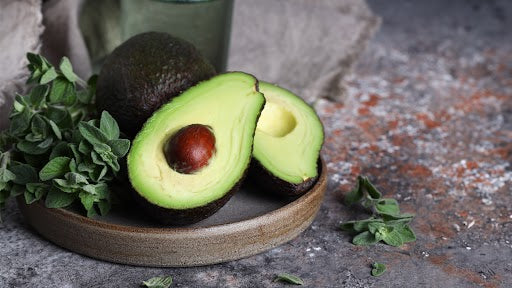
Avocado Oil For Babies: Gentle Benefits Of Nourishing Oil
Avocado oil has been a part of your kitchen for so long now it is becoming a part of your skincare routine. Known for its nourishing and hydrating properties, it is rich in vitamins, antioxidants, and healthy fats that works really well for your baby’s delicate skin.
When it comes to your baby, you naturally seek products that are as pure and gentle as possible. For centuries, the wisdom of Ayurveda has highlighted the importance of natural oils to promote a baby's wellness, believing that nature holds the key to soothing, protecting, and nourishing your baby's skin.
What is Avocado Oil?
Unlike many other essential oils, Avocado oil is not made from the seeds but extracted from the pulp of Avocado. It is enriched with antioxidants and moisturizing oil, known for its luxurious feel, and subtle scent. It is packed with nutrients that make it an ideal choice for your baby's delicate skin.
Avocado oil composition aligns beautifully with Ayurveda, which emphasizes natural ingredients that nourish and balance the body's doshas ( energy types). It has grounding and hydrating properties that make it suitable for your little one's skin, whose skin tends to be more vulnerable to dryness and irritation.
Nutrients in Avocado Oil
Vitamin E
Power pack of antioxidants that is essential for skin health. Vitamin E present in Avocado oil helps protect and soothe your baby's delicate skin against dryness and flakiness.
Essential fatty acids
Avocado oil is rich in healthy fatty acids, like oleic acids, which are known for their deep moisturizing properties. These fatty acids help strengthen the skin barrier by locking in moisture. For babies with naturally dry or sensitive skin, fatty acids offer gentle and lasting hydration.
Vitamin D and Beta carotene
These nutrients are also present in avocado oil in small amounts. While vitamin D is known for its properties like promoting skin health, beta carotene, is a precursor to vitamin A, offers skin-calming effects.
Benefits of Avocado oil for Babies

Here are some of the avocado oil benefits that make it an outstanding natural ingredient for supporting and protecting your baby’s delicate skin.
Hypoallergenic and Gentle
Avocado oil is known for its mildness, making it a good choice for the sensitive skin of your baby. Babies are prone to redness, and irritation due to their skin's delicacy. The gentle composition of avocado oil is less likely to cause discomfort to your baby.
Intensive Moisturizing Properties
Avocado oil for baby massage, It has the ability to deeply moisturize without feeling heavy or greasy. The fatty acids in the oil penetrate the skin easily, providing extra hydration.
Soothing Properties
Avocado oil's naturally soothing compounds, such as vitamin E and lecithin are perfect for calming skin discomforts like diaper rashes. Avocado oil for baby can help provide relief and restore skin texture.
How to use avocado oil safely for Babies
Avocado oil is incredibly versatile and can be used in several ways to care for a baby’s skin, from daily moisturizing routines to soothing specific problem areas.
Massage oil
Warm a small amount of avocado-infused baby body oil. Gentle massages are a great way to bond with your baby. You can give a body massage to your baby twice a day. Massaging before bedtime can help your baby relax and unwind.
Bath Additive
Just add a few drops of avocado oil in warm water for your baby’s bath. It will help in providing extra hydration to your baby’s delicate skin.
Diaper Rash Relief
Avocado oil has a cream texture that helps in nourishing your little one’s delicate skin. It also helps prevent diaper rashes and combat dryness.
Conclusion
You can incorporate Avocado oil into your baby's daily care routine. It will provide so many extra benefits like nourishment and hydration to your baby’s skin. This is a natural, safe, and effective ingredient to add to your baby’s daily care routine.

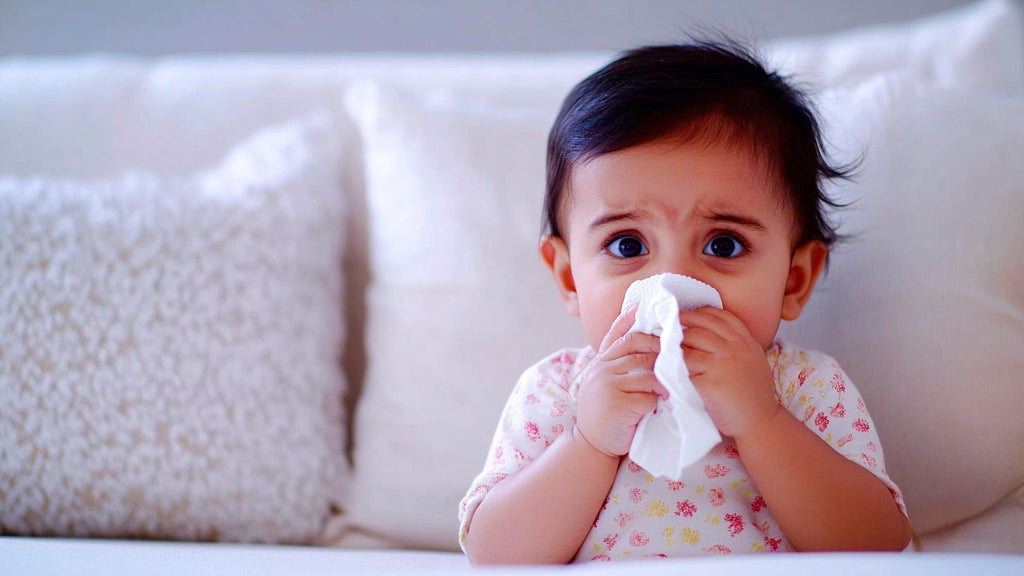
Why Is My Baby Sneezing So Much? Understanding Newborn Co...
If you’ve noticed your baby sneezing more than usual, it’s natural to feel a little worried. Is it a cold? Allergies? Or something else entirely? The good news is that sneezing in newborns is usually harmless and often a sign of their tiny bodies adjusting to the world around them. However, understanding why it happens and how to manage congestion can help you ensure your baby stays comfortable and healthy.
In this blog, we’ll explore the common reasons behind newborn sneezing and congestion, when to be concerned, and some simple ways to help your baby breathe easier.
Why Do Newborns Sneeze?
Newborn sneezing is a natural reflex that helps keep their nasal passages clear. Unlike adults, babies can’t blow their noses, so sneezing is their way of removing irritants like dust, milk, or mucus. Here are some common reasons your baby might be sneezing:
-
Adjusting to Air Quality
After spending nine months in the womb, your baby’s respiratory system is getting used to breathing air. Dust, pet dander, or even strong fragrances can cause sneezing as their tiny noses adapt to their new environment.
-
Clearing Mucus
Babies often have extra mucus in their nasal passages, especially in the first few weeks. Sneezing helps expel this mucus, keeping their airways clear.
-
Small Nasal Passages
A newborn’s nose is tiny, and even a little bit of congestion can make them sneeze more frequently.
-
Breast Milk or Formula Residue
Sometimes, milk can accidentally get into a baby’s nasal passages during feeding. Sneezing helps them clear it out.
-
Common Cold
If sneezing is accompanied by a runny nose, mild fever, or cough, your baby might have a common cold. Babies are more prone to colds since their immune systems are still developing.
What Causes Newborn Congestion?
Congestion in babies happens when their nasal passages are blocked or inflamed, making it harder for them to breathe. Here are some common causes:
-
Dry Air
During winter or in air-conditioned rooms, the air can become too dry, irritating your baby’s nasal passages.
-
Environmental Allergens
Dust, pollen, or smoke can irritate your baby’s sensitive nose and lead to congestion.
-
Teething
While teething, babies produce extra saliva, which can sometimes cause nasal congestion.
-
Infections
Viral infections like colds or mild respiratory illnesses can cause a stuffy or runny nose.
How to Identify If Your Baby Is Congested
Congestion in babies can make simple activities like feeding and sleeping a challenge. One of the common signs is snorting or noisy breathing, where you might notice a faint whistle or noise as your baby breathes. Congestion can also lead to difficulty in feeding, as a blocked nose makes it hard for your baby to nurse or drink from a bottle comfortably. Additionally, a congested baby may appear restless or fussy, especially during bedtime when lying flat can make congestion worse. You might also observe nasal discharge, either clear or thick mucus, which is another indication of nasal blockage. Recognizing these signs early can help you address your baby’s discomfort effectively.
Tips to Relieve Newborn Congestion
Congestion in newborns can often be managed with simple home remedies. Here are a few tips to help your baby breathe easier:
-
Use a Saline Nasal Spray
A saline spray is a safe and gentle way to loosen mucus in your baby’s nose. A couple of drops in each nostril can make a big difference.
-
Try a Bulb Syringe or Nasal Aspirator
These tools help remove mucus from your baby’s nose. Be gentle and only use them when necessary to avoid irritating their nasal passages.
-
Use a Humidifier
Adding moisture to the air with a humidifier can help relieve nasal dryness and congestion. Place it in your baby’s room, especially during winter months or if you use air conditioning.
-
Elevate Their Head Slightly
If your baby has trouble sleeping due to congestion, gently elevate the head of the crib mattress by placing a rolled towel underneath. Ensure it’s done safely to prevent any risk of rolling.
-
Use Baby Vapor Rub
For mild colds or stuffiness, a baby vapour rub like Baby Forest’s Komal Shwaas Vapor Rub can work wonders. This natural, gentle product contains soothing ingredients like eucalyptus oil, rosemary oil, and lavender oil. To use it, take a small amount on your fingers and gently rub it onto your baby’s chest, back, and the bottoms of their feet.This helps relieve congestion and makes breathing easier.

-
The Environment Clean
Reduce exposure to dust, smoke, and other allergens. Vacuum and clean regularly, and avoid using strong perfumes or sprays around your baby.
Conclusion
Sneezing and congestion can seem concerning, but they’re often just small bumps on the road of your baby’s growth. Understanding why your baby sneezes and how to handle congestion helps you care for them with confidence and ease.

How to Use Baby Vapour Rub for Cough Relief
When your baby has a cough, it can be distressing for both you and your little one. Babies, especially newborns, have delicate immune systems, which means even the smallest cold or cough can leave them feeling uncomfortable. As parents, we're always looking for safe and effective ways to bring relief to our babies, and one popular remedy is using baby vapour rub.
Vapour rubs are known to help ease congestion, clear stuffy noses, and provide relief from coughing. However, knowing how to use them correctly and safely is essential, especially for young infants. In this blog, we'll walk you through the benefits of using vapour rub for babies and share tips on how to use it effectively to provide relief from coughs and colds.
What is a Baby Vapour Rub?
Vapour rub is a soothing ointment that works by releasing comforting vapours from natural oils like eucalyptus and rosemary to help relieve congestion. When your baby is dealing with a stuffy nose or cough, these vapours open up the nasal passages, making it easier for them to breathe. This is especially helpful at bedtime when coughing can get worse, and sleep becomes difficult. Plus, many baby vapour rubs contain calming oils like lavender and thyme, which can help your little one relax and sleep better.
However, it's important to choose a vapour rub that's specifically made for babies. Regular vapour rubs, designed for adults, often have stronger ingredients that might be too harsh for your baby's sensitive skin and respiratory system. Baby vapour rubs are made with gentler, natural ingredients that are safe for your little one, giving them relief without any risks. So, always check the label to ensure it is baby-friendly!
How Does Vapour Rub Work?
When you apply vapour rub to your baby's chest, back, or feet, the warmth from their body helps release the soothing vapours into the air. These vapours are then inhaled, which helps to reduce nasal congestion and ease coughing. Some vapour rubs also contain essential oils that are absorbed through the skin, providing a calming and relaxing effect.
It's a popular remedy because it's non-invasive and doesn't require your baby to ingest anything, making it ideal for babies who are too young for over-the-counter medications. Vapour rub provides an effective way to support your baby's breathing while they're fighting off a cold or cough.
Tips for Using Baby Vapour Rub Safely
While vapour rub is generally safe for babies, it's important to follow a few precautions to make sure your baby gets the most benefit without any risks.
-
Check the age recommendations:
Always check the label to see to it that the vapour rub is suitable for your baby's age. Some products are designed specifically for babies over 3 months, while others may be safe from birth.
-
Do a patch test:
Babies have sensitive skin, so it's a good idea to do a patch test before applying vapour rub all over. Apply a small amount on your baby's forearm and wait for 24 hours to check for any allergic reactions or skin irritation.
-
Avoid applying near the nose or eyes:
Never apply vapour rub directly under your baby's nose or near their eyes, as the strong vapours can irritate these sensitive areas. Instead, focus on the chest, back, and bottoms of their feet.
-
Apply before bedtime:
Vapour rub works best when applied just before bedtime, as it helps to open up airways and provide comfort throughout the night.
How to Use Baby Vapour Rub for Cough Relief
Now that you know how vapour rub works, here's a step-by-step guide on how to use it effectively for your baby's cough relief:
-
Step 1:
Take a small, adequate amount of vapour rub on your fingertips.
-
Step 2:
Gently massage it onto your baby's chest, back, and bottom of their feet. You can also apply a small amount on their forehead.
-
Step 3:
Make sure the area is covered with light clothing to keep your baby warm and allow the vapours to work their magic.
-
Step 4:
For older babies (over 6 months), you can use a warm towel to cover the chest after applying the vapour rub for added comfort.
-
Step 5:
Reapply the vapour rub whenever necessary, especially before naps or bedtime.
Choosing the Right Vapour Rub
When choosing a vapour rub for your baby, it's important to go for a product made with natural, safe ingredients. One such option is the Baby Forest Komal Shwaas Vapour Rub, which is specifically designed for babies. It contains a blend of natural oils, such as eucalyptus oil, lavender oil, and rosemary oil, which are known for their soothing and congestion-relieving properties.
To use Baby Forest Komal Shwaas Vapour Rub, simply take an adequate amount on your fingers and apply it gently to your baby's chest, nose, forehead, and the bottom of their feet. Its gentle, natural ingredients like beeswax, coconut oil, and sesame oil make it perfect for your baby's sensitive skin, while the combination of essential oils helps calm the cough and open up the airways.
What's more, this vapour rub is free from parabens and is Ayush-certified, ensuring it's safe for your little one. The derma-safe formula means it's unlikely to cause irritation, and it provides a natural, non-invasive way to ease cough symptoms in your baby.
Additional Ways to Ease Your Baby's Cough
While vapour rub can be very effective, there are a few additional things you can do to make your baby more comfortable when they have a cough:
-
Use a humidifier:
Adding moisture to the air can help soothe your baby's irritated throat and loosen mucus, making it easier for them to breathe.
-
Elevate your baby's head:
If your baby has a stuffy nose or cough, gently elevate their head with a pillow (for older babies) or place a towel under the mattress for younger infants to help reduce congestion.
-
Offer plenty of fluids:
Keeping your baby hydrated is essential when they're not feeling well. If your baby is breastfeeding or formula-feeding, offer feeds more frequently.
-
Give them a warm bath:
A warm bath can help ease congestion and soothe your baby. The steam from the water helps open up their nasal passages, providing relief.
Conclusion
Using vapour rub is just one of the many ways to comfort your baby during a cough. However, it's important to remember that every baby is different. Some may respond quickly to vapour rub, while others might need additional care such as a humidifier or warm baths. The key is to create a comforting and soothing environment that helps your baby feel relaxed and secure.

How to Perform an Abhyanga Massage for Babies
Massaging your baby is not just a way to relax and bond; it’s a time-honored tradition that has been passed down through generations in India. Known as Abhyanga, this Ayurvedic practice involves the gentle application of warm oil all over the body. Abhyanga massages offer several benefits, including promoting healthy skin, improving circulation, and helping babies sleep better.
For new parents, performing an Abhyanga massage might feel intimidating at first, but with a little practice and patience, it can become a calming routine that both you and your baby look forward to. In this blog, we’ll walk through how to perform an Abhyanga massage for your baby step by step while also explaining the numerous benefits this practice provides.
What is Abhyanga Massage?
Abhyanga is a form of Ayurvedic massage that involves applying warm oil to the skin in long, gentle strokes. Traditionally, oils like sesame oil, coconut oil, or almond oil are used, each offering its own unique benefits. In babies, Abhyanga helps improve skin texture, promotes better blood flow, and can even soothe a fussy child, helping them to relax and sleep more soundly.
In Ayurveda, it is believed that regular oil massages help in balancing the doshas (Vata, Pitta, and Kapha) in the body, which is important for overall well-being. For babies, it also strengthens the immune system and supports their physical development.
Benefits of Abhyanga Massage for Babies
Before we explain how to give an Abhyanga massage, let’s look at why it’s so beneficial for your baby:
-
Improves Circulation:
The gentle strokes during the massage help boost blood flow, which is essential for healthy growth and development.
-
Promotes Relaxation:
A good massage helps soothe your baby’s nervous system, calming them down and making them feel secure.
-
Aids Digestion:
Massaging the stomach area can help with gas, colic, and constipation.
-
Boosts Immune System:
Regular massages help stimulate the lymphatic system, which in turn strengthens the immune system.
-
Encourages Better Sleep:
The warmth of the oil and the rhythmic movements promote relaxation, which helps babies sleep more soundly.

Choosing the Right Oil for Abhyanga Massage
Selecting the right oil for your baby’s massage is an important step. Some of the most commonly used oils include:
-
Sesame Oil:
This is a classic Ayurvedic oil known for its warming properties. It’s especially good for babies born in colder months as it helps retain body heat.
-
Coconut Oil:
Known for its cooling and moisturizing properties, coconut oil is great for babies born during the summer or those with sensitive skin.
-
Almond Oil:
Almond oil is rich in vitamin E, which nourishes the skin and is suitable for all skin types.
-
Olive Oil:
Often used in many homes, olive oil is light and easily absorbed, making it ideal for regular use.
How to Perform an Abhyanga Massage for Your Baby
Now that you know why Abhyanga is so beneficial, let’s break down the steps of giving your baby a soothing and effective massage.
Step 1: Set Up a Comfortable Space
Find a quiet, warm place in your home where you and your baby can relax. Lay down a soft towel or blanket on a firm surface. Make sure the room is at a comfortable temperature, so your baby doesn’t get too cold.
Step 2: Warm the Oil
Pour a small amount of your abyanga oil into a bowl and gently warm it. You can do this by placing the bowl in hot water for a few minutes. Make sure the oil is comfortably warm, but not too hot, by testing it on the inside of your wrist.
Step 3: Start with the Legs
Begin the massage with your baby’s legs. Using your hands, apply the warm oil and gently stroke downwards from the thigh to the ankle. Use firm but gentle pressure and remember to massage both the front and back of the legs. This helps stimulate circulation and muscle development.
Step 4: Move to the Arms
Next, apply oil to your baby’s arms, starting from the shoulders and working your way down to the wrists. You can also massage their tiny hands by gently opening their palms and pressing lightly on each finger. This not only improves circulation but also enhances sensory development.
Step 5: Massage the Chest and Tummy
With gentle strokes, massage your baby’s chest. You can make small circular motions around the chest area, which can help open up the lungs and improve breathing. When massaging the tummy, use circular motions in a clockwise direction to aid digestion and reduce gas or colic.
Step 6: Back and Spine
Gently turn your baby over onto their tummy and apply oil to the back. Using your hands, move in long strokes from the neck down to the bottom of the spine. This is especially relaxing for your baby and helps with the development of their spinal muscles.
Step 7: Massage the Head and Face
Lastly, apply a small amount of oil to your baby’s scalp and massage gently with your fingertips. This promotes hair growth and calms your baby. For the face, use your fingers to gently stroke from the centre of the forehead outward, down the nose, and across the cheeks.
Step 8: Finish with the Feet
Babies love having their feet massaged! Use your thumbs to press lightly on the soles of your feet in circular motions. This helps improve circulation and stimulates the nerve endings in the feet, promoting overall well-being.
Baby Forest’s Shishu Abhyanga Oils
For parents seeking a natural, safe, and effective oil for their baby’s Abhyanga massage, Baby Forest’s Shishu Abhyanga Oils is a fantastic option. This all-in-one oil combo set is designed to provide the perfect oils for your baby’s body and hair massage needs. The combo includes:
-
Maasoom Malish Baby Body Massage Oil:
A gentle body massage oil that nourishes and hydrates your baby’s skin, perfect for daily use.
-
Nanhi Champi Baby Hair Massage Oil:
This oil promotes healthy hair growth and strengthens the scalp, making it ideal for regular head massages.
-
Badami Sneh Organic Almond Cold Pressed Oil:
Rich in vitamin E, this oil deeply nourishes your baby’s skin, leaving it soft and smooth.
-
Narial Tailam Organic Cold Pressed Coconut Oil:
Known for its cooling and moisturizing properties, this coconut oil is perfect for keeping your baby’s skin hydrated, especially during warmer months.
What makes the Shishu Abhyanga Oils even more special is the addition of a complimentary surprise gift—a delightful toy or a handy travel kit, making the set a complete package for your baby’s care routine.
To use these oils, simply warm a small amount in your hands and apply it gently to your baby’s body or hair, following the steps outlined for an Abhyanga massage. The nourishing blend of natural oils will help relax your baby, improve their skin and hair health, and promote restful sleep, making it an essential part of your baby’s daily care routine.
When Should You Do Abhyanga?
Abhyanga can be done daily, preferably before bath time. Some parents like to do it in the morning, while others prefer a gentle massage before bedtime to help their baby sleep. Whatever time you choose, try to be consistent so your baby begins to recognize the routine and feel secure.
Conclusion
As you incorporate Abhyanga into your baby’s daily routine, you’re not only helping their body grow and develop but also nurturing their sense of security and love. So, take your time, enjoy the process, and know that with each gentle stroke, you’re supporting your baby’s health and happiness.
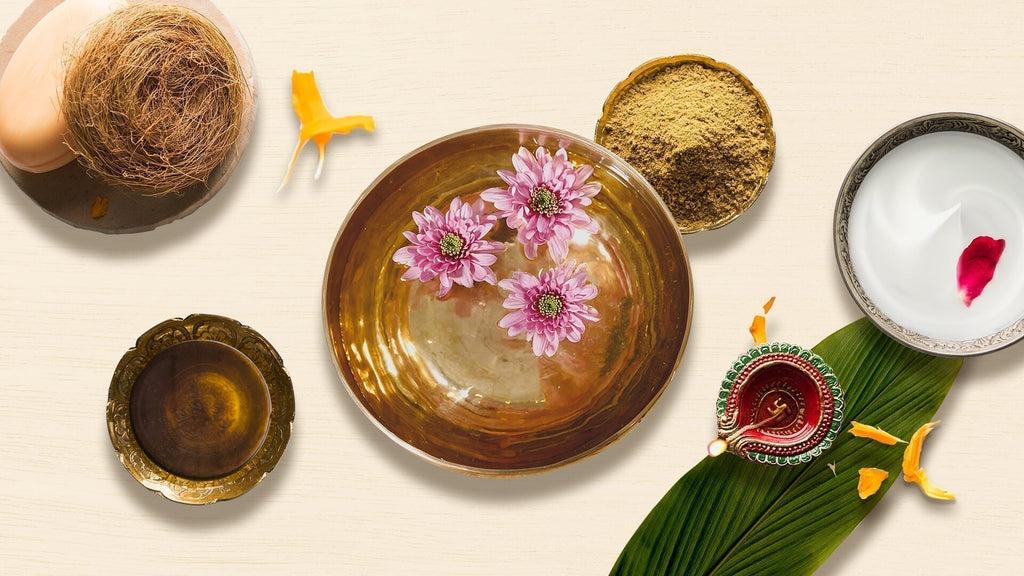
Baby Bath Ritual: An Essential Ritual for Baby’s Growth &...
Baby bath rituals in India are deeply rooted in the ancient holistic wellness concepts of Ayurveda and are intrinsic to mother and childcare. According to Ayurveda, bathing is a therapeutic, healing experience that restores physical energy, removes accumulated toxins, sweat, and dirt from the baby’s skin, and relaxes the mind by balancing emotions. While it may seem like a simple task, a baby bath ritual is packed with benefits that go beyond just cleanliness.
A baby’s first bath is considered one of the most nourishing, cleansing, and comforting experiences in their early life.
Benefits of Bathing a Baby Daily
Many parents wonder whether they should bathe their baby every day. The benefits of bathing a baby daily is numerous and go far beyond maintaining hygiene. Daily baths, especially at a fixed time, help relax the baby, restore their balance, and promote natural growth. Establishing this routine can make the baby feel more secure and comfortable.
-
Calms and Relaxes
Bathing has a calming effect on babies, which can help them sleep better, particularly if included as part of their bedtime routine.
-
Cleanses Skin Gently:
Daily bathing helps remove dirt, sweat, and accumulated oils, ensuring your baby’s skin stays fresh and healthy.
-
Promotes Circulation:
Bathing improves blood circulation, which helps the baby's muscles relax, fostering overall physical development.
How to Bathe a Newborn: A Step-by-Step Guide
Understanding the proper baby bath procedure is essential for new parents. Bathing a newborn may seem overwhelming, but following these steps can make the experience smooth and enjoyable.

Step 1: Warm Oil Massage Before Bath Time
According to Ayurveda, a warm oil body massage is essential for the baby as it controls aggravated Vata Dosha, emphasizing the belief that touch therapy creates a beautiful, deep bond between the mother and child. Before the bath, use gentle oils to massage the baby’s body, helping soothe their muscles and prepare them for the bath.
Baby Forest has formulated the Maasoom Maalish baby body massage oil with a blend of 10 Ayurvedic essential oils. These oils, derived from herbs, flowers, and medicinal plants, strengthen the baby’s blood vessels, improve blood circulation, and help in bone development.
Step 2: Gentle Cleanse During the Bath
According to Ayurvedic philosophy, a bath helps in eliminating stress, cleansing the skin, and soothing the nerves.
To ensure a gentle cleanse, use Baby Forest’s luxurious Sampoorna Snan Baby Body Wash. This product, enriched with Ayurvedic herbs and oils, keeps your baby’s delicate skin hydrated, maintains its natural moisture, and leaves it soft and supple.
Step 3: Deep Moisturizing After Bath
After a refreshing bath, it’s crucial to lock in moisture to prevent your baby’s skin from drying out. Apply the Moh Malai Baby body lotion, a lightweight, deeply hydrating cream enriched with Shea butter, Rose Petals, and Mulethi. It penetrates deeply into the skin, ensuring intense moisturization and nourishment.
Must Have Baby Hair Care Products
Many parents overlook the importance of caring for their baby’s hair. Just like skin, a baby’s hair requires gentle care and attention. Baby hair products that are mild and formulated for sensitive skin are crucial to ensure that the baby’s scalp stays clean and healthy.
-
Shampooing:
Use a mild baby shampoo that’s free from harsh chemicals. A gentle formula cleanses without stripping away the natural oils, keeping the scalp healthy.
-
Hair Oil:
For babies with a dry scalp, applying a small amount of baby hair oil can help keep their hair soft and manageable.
Baby Forest offers specially formulated baby hair care products that are gentle on the baby’s scalp and keep their hair healthy and shiny.

Creating a Soothing Bath Time Routine
The key to a successful baby bath procedure is making sure the environment is calm, and the baby feels secure. Here’s how to make the process even more soothing for your baby:
-
Use Soothing Music or Lullabies:
Playing soft music or singing to your baby during bath time can create a comforting atmosphere.
-
Introduce Bath Toys:
For older babies, adding toys to bath time can make the experience more engaging and fun.
-
Maintain Eye Contact and Smile:
A reassuring smile and gentle eye contact help your baby feel safe and loved during the bath.
Baby Bath Essentials: What You Need
Having the right products makes all the difference in ensuring a smooth, safe, and enjoyable bath time. Here’s a quick look at the must-have baby bath essentials:
|
Bath Essential |
Why You Need It |
|
Mild Baby Soap |
Gentle on your baby’s sensitive skin, cleanses without irritation. |
|
Soft Washcloth |
Perfect for cleaning those tiny folds and creases. |
|
Baby Bathtub |
Provides a safe, secure space for the baby to bathe. |
|
Hooded Baby Towel |
Keeps your baby cozy and warm right after the bath. |
|
Moisturizing Lotion |
Helps lock in moisture, protecting delicate skin from dryness. |
|
Water Thermometer |
Ensures the bathwater is at a safe, comfortable temperature. |
Conclusion
Incorporating a daily bath routine for your baby is not just about maintaining hygiene but also about promoting overall growth and wellness. With the right baby bath products, a gentle bath procedure, and some love and care, you’re ensuring that your baby enjoys both the physical and emotional benefits of this calming ritual.
Make bath time a bonding moment that relaxes your baby, supports their growth, and keeps them happy and healthy!
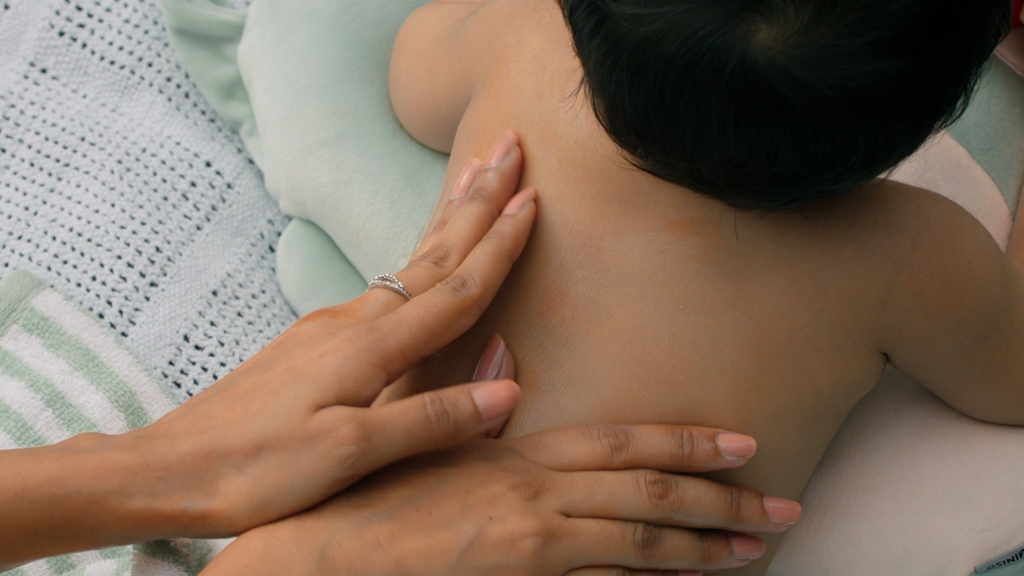
Essential Oils Benefits for Babies: A Complete Guide for ...
The arrival of a newborn is a beautiful and transformative experience that inspires you to seek the best ways to care for your precious bundle of joy.

Best Ways to Get Rid of Mosquitoes This Monsoon
Monsoon brings the refreshing smell of rain, cooler temperatures, and beautiful greenery. But along with all this goodness comes something not so pleasant – mosquitoes. These tiny pests are more than just annoying; they can also carry serious diseases like dengue, malaria, and chikungunya. And if you have infants or young kids at home, the concern is even greater. Keeping them safe from mosquito bites becomes a top priority. But don't worry! In this blog, we'll explore the best ways to get rid of mosquitoes this monsoon, focusing on safe and effective solutions for everyone, especially your little ones.

-
Use Natural Mosquito Repellents
One of the safest ways to protect your baby from mosquitoes is by using a mosquito repellent for infants that is free from harmful chemicals. Mosquito repellents come in various forms – sprays, creams, and patches. However, choosing the right one for your little one is crucial. Look for natural options that use plant-based ingredients. For instance, Baby Forest's Mashak Kawach Baby Mosquito Repellent Spray is a great choice. It's made from a 100% natural blend of essential Ayurvedic herbs like Bhustarah (Lemongrass oil), Cedarwood, and Lavender Oil, which create a protective layer over your child's skin without any harmful chemicals. This ensures your baby is safe from both mosquito bites and harsh toxins.
-
Keep Your Home Mosquito-Free
It is important that you keep mosquitoes out of your home, especially during monsoon when they breed rapidly in stagnant water. Simple preventive measures can go a long way in controlling mosquito populations inside your house:
-
Use window and door screens:
You can simply start by making sure that all the windows and doors have proper screens to keep mosquitoes out while letting fresh air in. -
Mosquito nets:
If your child sleeps in a crib or bed, consider using a mosquito net. This physical barrier is highly effective, especially for protecting infants during sleep. -
Natural repellents at home:
You can place natural mosquito-repelling plants like basil, citronella, and lemongrass around your house. These plants are known to repel mosquitoes and add a touch of greenery to your home.
-
Remove Stagnant Water
Mosquitoes love stagnant water, and the monsoon season often leaves puddles and waterlogged spots around our homes, making it the perfect breeding ground for them. So, what can you do? First, empty out any containers, pots, or buckets that might be collecting water outside. Even small things like plant saucers, birdbaths, or old tires can turn into mosquito breeding spots if left unchecked.
Also, take a look around your home to fix any drainage issues. Clogged drains or broken pipes can cause water to pool up, which is exactly what mosquitoes are looking for. If you store water, make sure it's tightly covered to keep mosquitoes out.
-
Dress Your Baby in Protective Clothing
With other measures, you can also dress your baby in the right kind of clothing to keep the mosquitoes away. Pick one that is light-coloured and loose-fitting with long sleeves and pants, as these create a physical barrier between mosquitoes and your baby's skin.
-
Use Mosquito Traps and Zappers
Electronic mosquito zappers and traps are great for cutting down the number of mosquitoes inside your home. By placing them near windows or other entry points where mosquitoes tend to enter, you can noticeably reduce their numbers indoors and create a safer, mosquito-free environment for your family.
-
Essential Oils for Mosquito Control
Essential oils such as eucalyptus, tea tree, citronella, and lavender are known for their mosquito-repelling properties. These oils can be used in a diffuser, mixed with water, and sprayed around your home. Since essential oils are natural, they are a safer option for homes with infants. However, always ensure the oils are properly diluted and avoid using them directly on your baby's skin without consulting a pediatrician.
-
Safe Outdoor Protection
If you are planning to spend time outdoors with your baby during the monsoon, whether it's for a walk or playtime in the park, it's important to take extra precautions. Always apply a mosquito repellent for infants, which offers safe protection with its natural ingredients. Combine this with the use of a mosquito net on strollers or carriers to protect your baby while outside.
-
Maintain Hygiene Around Your Home
Cleanliness plays a major role in reducing mosquito populations. Dispose of garbage regularly and ensure waste bins are always covered. Trim overgrown bushes or plants near your home, as these areas can become breeding spots for mosquitoes.
Conclusion
Monsoons can bring more mosquitoes, but with a few simple precautions, you can keep your baby safe and comfy all season long. Using a mosquito repellent for infants, like Baby Forest's Mashak Kawach Baby Mosquito Repellent Spray, and taking steps around your home to prevent mosquito breeding are great ways to minimize exposure.
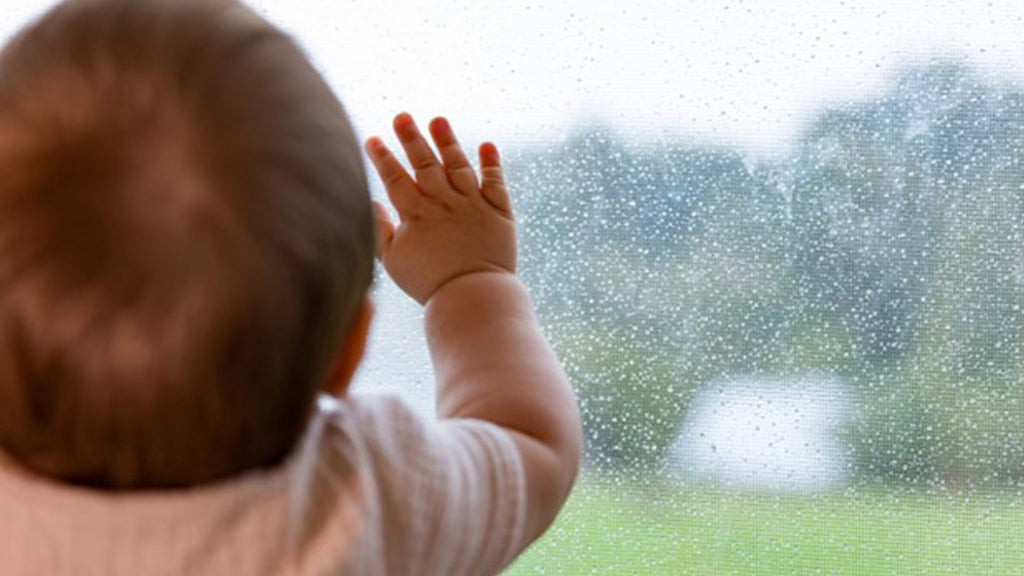
Must-Have Baby Essentials for a Safe and Comfortable Monsoon
The monsoon season brings with it a refreshing break from the heat, but it also introduces new challenges for parents of young babies. High humidity, increased moisture, and cooler temperatures can affect your baby's comfort and health. Preparing with the right baby essentials can make a big difference in ensuring your little one stays safe and comfortable during the rainy season. Here's a detailed guide on must-have baby products for a safe and comfortable monsoon.

Essential Baby Products for this Monsoon
Talc-Free Baby Powder
During the monsoon, the increased humidity can cause your baby to sweat more, which can lead to heat rashes and discomfort. A talc-free baby powder is essential to keep your baby's skin dry and prevent rashes. The Dulaar Pyar Baby Powder is made from natural ingredients like corn starch and oats kernel, which are gentle on your baby's delicate skin. This talc-free powder helps absorb excess moisture and reduce friction, keeping your baby's skin smooth and dry throughout the humid season.

Baby Vapour Rub
Monsoon weather often brings cooler temperatures and can exacerbate colds and respiratory issues in babies. A baby vapour rub is a must-have during this monsoon. The Komal Shwaas Baby Vapour Rub is formulated for infants and contains natural ingredients like eucalyptus and lavender oils. These ingredients help relieve nasal congestion, making breathing comfortably easier for your baby. Apply a small amount on your baby's chest, back, and soles of their feet before bedtime to help them sleep better during cold and damp nights.

Baby Rash Healing Cream
Wet weather and frequent diaper use can increase the likelihood of diaper rashes. A baby rash healing cream must be on hand during monsoon. Baby Forest’s Komal Kawach Diaper Rash Healing Cream contains Kusha, Harachampaka Madanah, and Geranium oil that creates a protective layer and keeps the baby’s skin soft, dry and supple. It also includes soothing ingredients like Aloe Leaf Juice and Jojoba oil. Regularly applying a rash cream can prevent rashes from developing and ensure that any existing rashes heal quickly.

Natural Floor and Baby Toy & Surface Cleaner
Monsoon season often brings mud and dirt indoors, increasing the risk of germs and bacteria that can affect your baby's health. A natural floor cleaner and, a baby toy & surface cleaner are vital for keeping your home clean and safe for your baby. The Swaksh Bhoomi Natural Floor Cleaner is made from natural, non-toxic ingredients, ensuring your baby is not exposed to harsh chemicals. This cleaner disinfects floors and surfaces, providing a hygienic environment for your baby to crawl and play safely. Similarly, the Swaksh Khilone Baby Toy & Surface Cleaner is designed to keep toys and surfaces free from germs, using non-toxic ingredients. Regular use of these cleaners helps maintain hygiene and reduces the risk of infections, especially during the monsoon when mold and mildew can thrive.

Pashmina Baby Blanket
Keeping your baby warm and cozy during the cooler monsoon months is important. A Pashmina baby blanket is an excellent choice for this purpose. Our Kashmiri Pashmina Baby Blanket is made from incredibly soft pashmina wool, which is lightweight and provides excellent insulation. These blankets are perfect for wrapping your baby during naps or bedtime, offering warmth without overheating. Pashmina blankets are also breathable, preventing your baby from getting too hot and ensuring they stay comfortable. Its luxurious feel makes them a comforting and soothing choice for your baby.

Baby Swaddles
Swaddling helps babies feel secure and improves their sleep quality, which is especially beneficial during the monsoon when the weather can be unpredictable. Baby swaddles made from soft, breathable fabrics like cotton or muslin are ideal. The Komal Aavran Baby Swaddle is made from soft, breathable fabric that helps regulate your baby's body temperature, preventing overheating while keeping them snug. Swaddling can also reduce the startle reflex, which often wakes babies up.

Baby Towel
When it comes to keeping your baby dry and comfortable after baths, the Somya Aanchal Baby Towel is an excellent choice. This towel offers exceptional absorbency and softness, made with a blend of 60% zero-twist cotton and 40% bamboo. The hooded design adds a touch of cuteness and ensures your baby's head stays warm, which is especially important during the cooler monsoon months. Generously sized for ample coverage, this towel is gentle on your baby's delicate skin and provides the ultimate comfort after bath time.

Additional Tips for a Safe and Comfortable Monsoon
-
Maintain a Clean Environment
Regularly clean your baby's room and play areas to prevent mold and mildew, which thrive in humid conditions. -
Dress Appropriately
Dress your baby in lightweight, breathable clothing to prevent overheating. Layering is a good strategy, as you can easily add or remove layers based on the temperature. -
Monitor Humidity Levels
Use a dehumidifier to control indoor humidity levels. High humidity can cause discomfort and promote the growth of mold and bacteria. -
Stay Dry
Ensure your baby stays dry by promptly changing clothes and diapers. Wetness can cause skin irritation and rashes.
Preparing for the monsoon season with the right baby products can significantly improve your baby's safety and comfort. Each item plays a crucial role in addressing the unique challenges of the rainy season, from talc-free baby powder to keep their skin dry to a pashmina baby blanket for warmth. Incorporating these products into your daily routine will help you easily navigate the monsoon, keeping your baby happy, healthy, and comfortable. Remember, the key to a stress-free monsoon is preparing and choosing high-quality products catering to your baby's needs.

Buying a Baby Towel? Here’s what you need to know!
Choosing the right baby towel is essential for your baby's comfort and hygiene. With so many options available, it can be overwhelming to decide which towel is best for your little one. In this guide, we'll explore the key factors to consider before purchasing a baby bath towel, ensuring you make an informed decision that keeps your baby warm, dry, and comfortable.
Factors to Consider While Purchasing a Baby Bath Towel:
Soft and Comfortable
One of the most important features to look for in a baby towel is its softness. A soft bath towel for a baby is gentle on your baby's delicate skin, reducing the risk of irritation and discomfort. Babies have much more sensitive skin than adults, so using a towel that is soft and plush can make bath time a pleasant experience.
When shopping for a baby bath towel, consider the material. Towels made from natural fibres like cotton are usually softer and more comfortable. A cotton towel for a baby is an excellent choice because it is not only soft but also breathable, ensuring your baby's skin stays healthy and free from rashes.
Highly Absorbent
The primary function of a towel is to dry, so it's crucial to choose a baby towel that is highly absorbent. After a bath, you want to be able to dry your baby quickly and efficiently to prevent them from getting cold. Look for towels that are thick and have a high absorbency rate, as these will soak up moisture effectively.
Materials like cotton and bamboo are known for their excellent absorbency. A blend of these materials can offer superior performance. For instance, our baby towel combines 60% zero-twist cotton, and 40% bamboo providing exceptional absorbency, making it ideal for drying your baby quickly after a bath.
Eco-Friendly
In today's world, making eco-friendly choices is more important than ever. When selecting a baby bath towel, consider the environmental impact of the product. Towels made from organic cotton or bamboo are great eco-friendly options. These materials are sustainable and biodegradable, reducing your environmental footprint.
Organic cotton is grown without harmful pesticides and chemicals, making it safer for your baby and better for the environment. Bamboo is another excellent choice as it grows quickly without the need for fertilizers or pesticides. Choosing an eco-friendly cotton towel for your baby not only benefits the planet but also ensures that your baby's skin is not exposed to harmful substances.
Durable
Durability is another crucial factor to consider when buying a baby towel. Babies can be messy, and their towels will need frequent washing. A durable towel will withstand repeated laundering without losing its softness or absorbency.
High-quality towels made from strong fibers like cotton and bamboo are more likely to remain in good condition over time. Investing in a durable soft bath towel for your baby means you won't have to replace it frequently, saving you money in the long run.
Hooded Towel for Baby
A hooded towel for the baby adds an extra touch of practicality and cuteness to bath time. The hood helps keep your baby's head warm after a bath, which is especially important for young babies who can lose heat quickly. A hooded towel also makes it easier to wrap and dry your baby, ensuring they stay snug and comfortable.
Hooded towels come in various designs and sizes, so you can choose one that best fits your baby's needs. The hooded design not only looks adorable but also provides additional warmth and coverage, making it a must-have item for bath time.
Why Choose Somya Aanchal Baby Towel?
Choosing the Somya Aanchal Baby Towel ensures you're providing your baby with the best in comfort, absorbency, and eco-friendliness. This towel stands out because it combines the softness of 60% zero-twist cotton with the sustainability of 40% bamboo, making it exceptionally gentle on your baby's delicate skin. The generous size offers ample coverage, keeping your baby warm and cosy after bath time. The hooded design not only adds an adorable touch but also provides extra warmth for your baby's head. Additionally, the high absorbency of the Somya Aanchal Baby Towel ensures quick drying, making it an essential item for every new parent who values quality and practicality.

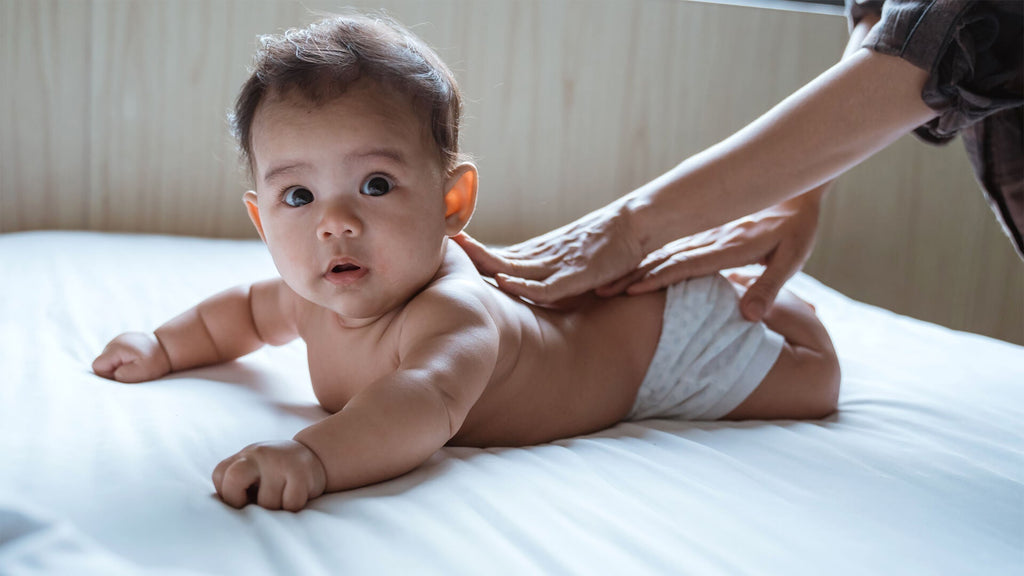
Shishu Abhyanga (Baby Oil Massage): The Ancient Ayurvedic...
Shishu Abhyanga or Baby Oil Massage, is an ancient Ayurvedic tradition widely practiced in India among new parents. It is well-known that regular oil massage has many benefits for a baby. Infant’s skin is delicate and sensitive; therefore, daily oil massage can promote healthy skin, provide relief from dryness, and hydrate skin to keep your baby protected. In addition to this, your baby will have increased blood circulation, strengthening the immune system and enhancing physical development. Hence, baby massage is a ritual that promotes physical, mental, and emotional well-being and can be performed daily to promote strong bonding between mother and child.
We’ve put together a baby massage guide featuring simple step-by-step instructions so that anyone can easily practice this ancient Ayurvedic tradition at home. Before starting a massage, you must take some precautions as described below:
Precautions:
- Abhyanga should be done preferably in the morning.
- Use a clean sheet while giving a massage.
- Use a slightly warm oil for giving a baby massage. Take a few drops on your palm before applying to your baby’s skin to avoid skin burn.
- Do not give a massage on a full stomach as sudden aspiration can occur. If the baby has been fed, it is best to wait for an hour before the massage.
- The pressure should be gentle to moderate.
- Massage must be done with clean hands and nails. You must trim the nails to avoid causing any harm to the baby’s skin.
- Make sure oil is not in contact with the baby’s eyes.
- Use caution when holding and massaging the baby to avoid falls and injuries.
- Babies should always be kept warm & well covered after Abhyanga.
Step By Step Process to Give Shishu Abhyanga:
Baby oil massage can be one of the best ways to bond with your baby. Not only does it help you to connect with your baby, but it also helps to relax them, making it easier for both of you to fall asleep at night. However, performing a massage can be difficult when you have never done one before. Here is a step-by-step process to give your baby a massage using baby oil in simple steps:
Step 1: Get Your Baby Ready
The first thing you must do is get your baby ready for their massage. You should make them feel comfortable and relaxed, so make sure that they are wearing something soft and comfortable, such as a t-shirt or onesie. It is also important that the room is warm enough, so check the room temperature on your thermostat to ensure that it is comfortably warm for your baby.
Step 2: Prepare the Area
You will need ample area to give Shishu Abhyanga. The bed, floor, or changing table are good options. Then place a towel on the surface and lay your baby down. The towel will prevent you from getting baby oil on the beg or table, and it will also provide a comfortable, soft surface for your little one.
Step 3: Select Oil
Always select an unscented oil that’s safe for babies, such as mineral oil, coconut oil, or olive oil. You can give a massage with Baby Forest Maasoom Maalish baby body massage oil. This oil is a mishran of 10 Ayurvedic natural essential oils of herbs, flowers, nut oils, and medicinal plants that are good for baby skin.
Pour some onto your hands and rub them together to warm it up before you start massaging your baby’s body.
Step 4: Lower Body Massage
Slowly massage heels and toes with firm, gentle strokes. Hold baby by one hand at all times. Then massage the leg from ankle to thigh and from hip to hip. Smoothly massage the leg for several minutes. It is recommended to do this on both legs simultaneously. Do not rub the genital area.
Step 5: Upper Body Area
Massage the upper back by placing both hands in the downward direction from shoulders to waist. After that, massage each arm separately. Start from the wrist up to the shoulder by making circular motions with the fingers and palms of hands. Repeat this process for another arm also.
Step 6: Back Massage
After massaging the front of your baby’s body, turn them onto their tummy and massage them from head to toe. Make sure your touch is soothing. Take a pause if you feel your baby is uncomfortable.
Step 7: Face Massage
Massage the baby’s face with your finger pads. You should begin at the middle of the forehead, down the outer side of the baby’s face, and then in toward the cheeks. Gently massage the scalp in small circular motions.
When to Perform Abhyanga Properly
Abhyanga, or Ayurvedic oil massage, can be introduced to newborns after their umbilical cord stump has healed, typically around 10-14 days old. The best time to perform Abhyanga is before a bath, ideally in the morning or early evening when the baby is calm and alert. Ensure the room is warm and draft-free to keep the baby comfortable. Abhyanga can be done daily or several times a week, depending on the baby's skin type and routine. It is essential to observe the baby's response to the massage and adjust the frequency and duration accordingly to ensure a positive and soothing experience.
Benefits of Shishu Abhyanga
Shishu Abhyanga, or infant massage, offers numerous benefits for both the baby and the caregiver. It promotes better sleep patterns and helps in the development of the baby's nervous and immune systems. Regular massage can improve blood circulation, support healthy skin, aid in digestion, and reduce colic and gas. Additionally, Shishu Abhyanga strengthens the bond between the baby and the caregiver, providing a sense of security and comfort through physical touch. The gentle massage also helps in the overall growth and development of the baby, contributing to a calm and happy demeanor.
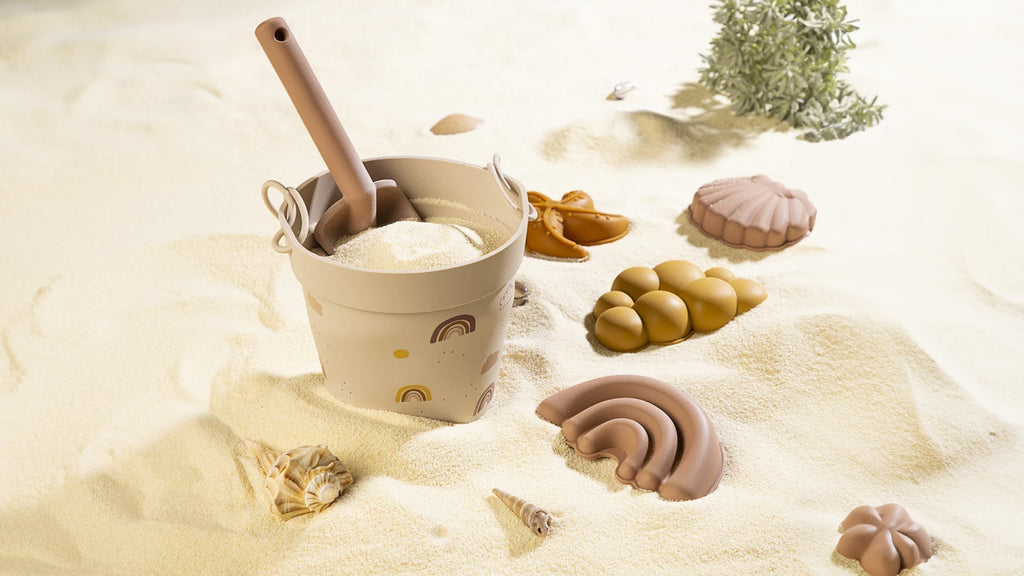
Essential Tips for a Perfect Beach Day with Kids this Summer
A beach day with kids can be a great way to spend the summer, but it takes careful planning to ensure everything runs properly. There are various factors to consider, like carrying the appropriate gear and keeping your children safe and entertained. This blog contains a few tips to help you have a fantastic beach day with your children.
Preparation is Key
Before you head to the beach, make a checklist of all the items you need to bring. Preparation ensures that you have everything necessary to keep your children comfortable, safe, and entertained. This includes beach toys, sun protection items, food, and drinks. It's always better to be over-prepared than to realize you've forgotten something crucial once you're already at the beach.
Sun Protection
One of the most important aspects of a beach day is protecting your kids from the sun. Young children have sensitive skin that is more prone to sunburn. Apply a broad-spectrum SPF30 baby sunscreen lotion to your child's skin about 30 minutes before sun exposure. Reapply every two hours or after swimming. Choose a sunscreen made exclusively for babies, ensuring that it is mild on their sensitive skin. Make sure your children are wearing wide-brimmed hats to shield their faces and necks from the sun. Setting up a beach umbrella or tent provides a shaded area where your kids can take a break from the sun. This is especially crucial during peak sunlight hours, which normally occur between 10 a.m. and 4 p.m.
Beach Toys and Entertainment
Keeping your kids entertained at the beach is crucial for a fun day. Bringing along the right beach toys can make a significant difference. The beach munchkin bucket is a versatile toy that can provide hours of entertainment. Your kids can use it to build sandcastles, collect seashells, or even catch small sea creatures. It's lightweight, portable, and ideal for beach trips. If your children enjoy swimming, inflatable toys and floaties are great additions. They can float on the water safely and have fun splashing around.
Baby Care Essentials
When spending a day at the beach with a baby, having the right baby care essentials is critical. Baby wipes are indispensable for cleaning up messes, wiping sandy hands, and even cooling down your baby's skin. Choose wipes that are gentle and free of artificial fragrance to avoid irritation. Talc-free baby powder is perfect for removing sand from your baby's skin. Sprinkle some powder on their skin and brush off the sand effortlessly. This simple trick can keep your baby comfortable and free from irritation. Keep your kids hydrated by offering water frequently. Pack healthy snacks like fruits, crackers, and sandwiches to keep their energy levels up throughout the day.
Appropriate Beachwear for Babies
Choosing the right beachwear for your baby is essential for their comfort and protection. A Hand Embroidered Gather Top with Underpants is a cute and stylish outfit that is perfect for a beach day. The lightweight fabric keeps your baby cool, while the hand embroidery gives a touch of elegance. The underpants provide coverage and keep the sand out. A full-sleeved baby bodysuit set offers excellent sun protection for your baby's delicate skin. Look for ones made from breathable materials that dry quickly. This outfit is perfect for cooler beach days or when you need extra sun protection. An overlapping baby bodysuit is simple to put on and remove, making diaper changes a quick game. The design ensures that your baby stays comfortable, and the soft fabric is gentle on their skin.
Safety Tips
Always keep a close eye on your kids, especially when they are near the water. Designate a responsible adult to supervise at all times. Teach your children basic water safety rules, such as not swimming alone and understanding the dangers of strong currents. Pack a simple first aid kit that includes bandages, antiseptic wipes, and other items you'll need to heal small wounds. Dehydration can occur quickly under the sun. Ensure your kids drink plenty of water and take breaks in the shade to cool down.
After the Beach
After a fun-filled day at the beach, there are a few things to keep in mind. Rinse off the sand and saltwater from your kids' skin and hair. Check your child's skin for any signs of sunburn. If you notice redness or irritation, apply aloe vera gel or a soothing lotion to ease the discomfort.
A beach day with kids can be a delightful and memorable experience with the right preparation and care. By ensuring proper sun protection, bringing the right toys, packing essential baby care items, and choosing appropriate beachwear, you can create a perfect beach day for your family. Remember to prioritize safety, stay hydrated, and engage your kids in fun activities. With these tips, you are well-equipped to enjoy a wonderful day at the beach with your little ones this summer.
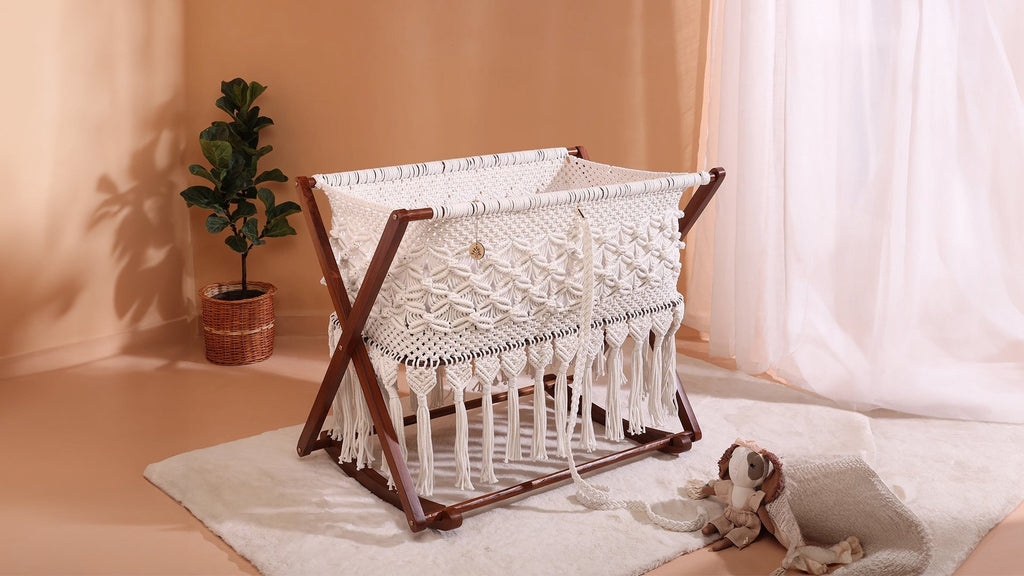
07 Things to Know Before You Buy a Baby Cradle in India
Buying a baby cradle is one of the most significant decisions for new parents, as it provides a safe and comfortable space for your little one to sleep. With various options available in the market, choosing the right cradle can be overwhelming. This guide will help you understand the essential aspects to consider before purchasing a baby cradle in India, ensuring you make an informed and thoughtful choice.
Importance of a Handmade Cradle
Handmade cradles are crafted with care and precision, often featuring unique designs and superior quality. Usually, these cradles are crafted by expert artisans who take great care to ensure both longevity and safety. A handmade baby cradle not only adds an aesthetic appeal to your baby's nursery but also provides a personal touch that mass-produced cradles lack. In India, handmade cradles are often made from natural materials like wood, which are safe and non-toxic for your baby.
Benefits of a Detachable Rocker
A detachable rocker is a valuable feature to look for in a baby cradle. The gentle rocking motion mimics the movements of a mother's arms, providing a sense of security and relaxation for your baby. This can be particularly soothing during nap times or when your baby is fussy. The ability to detach the rocker allows for versatility, as you can use the cradle as a stationary bed when needed. This feature ensures that the cradle can adapt to different situations and needs, making it a practical choice for parents.
Durability is Key
When buying a baby cradle, durability is a crucial factor to consider. You want a cradle that will last through your baby's early years and potentially be used for future siblings. Look for cradles made from sturdy materials like natural wood, which is known for its strength and longevity. A well-made cradle will endure normal wear and tear and give your child a secure place to sleep. Check for features like strong joints, smooth finishes, and stable bases to ensure the cradle's durability.
The Charm of Natural Wood
Natural wood cradles are a popular choice among parents due to their aesthetic appeal and safety. Wood is a durable and sturdy material that provides a stable sleeping environment for your baby. In addition, natural wood is suitable for young children because it doesn't contain any poisons or dangerous compounds. Wooden cradles also tend to have a timeless look, fitting seamlessly into various nursery themes and styles. Wood is also simple to keep and clean, so your baby's sleeping space will always be safe and hygienic.
Ease of Assembly
As a new parent, you'll appreciate a cradle that is easy to assemble. Look for cradles that come with clear instructions and all the necessary hardware. Choosing an easy-to-assemble cradle saves time and allows you to prioritize other duties. Additionally, an easy-to-assemble cradle can be conveniently moved and reassembled in different rooms as needed. This flexibility is especially beneficial in the early months, when you may want to keep your infant close at all times.
Value for Money
When investing in a baby cradle, it's important to consider the value of money. While it might be tempting to opt for the cheapest option, remember that a high-quality cradle will provide better safety, comfort, and durability. Consider the features, materials, and craftsmanship of the cradle to ensure you're getting the best value for your investment. A durable cradle can be used for several children and passed down to future generations, making it a good investment.
Baby Forest's macrame wooden baby cradle combines the beauty of handmade craftsmanship with the durability of natural wood. These cradles frequently contain complex macrame designs, which offer a sense of elegance to the nursery. The gentle, detachable rocking motion of a macrame wooden cradle mimics the soothing movements of a mother's arms, helping your baby feel secure and relaxed. Measuring approximately 36x36x20 inches, these cradles are ideal for babies up to 3 years of age, providing a comfortable and spacious sleeping area.
Related Read - A Guide to Creating the Perfect Sleep Space for Your Baby

The Benefits of Regular Baby Massages - A Parent's Guide
As a parent, you're always looking for ways to give your baby the best start in life. One simple yet profound method to boost your baby's health and strengthen your bond is through regular baby massages. Baby massage is an age-old tradition with numerous benefits that can support your child's emotional and physical development. This guide will explore why incorporating massage into your daily routine can be a rewarding experience for both you and your baby.
Baby massage involves gently rubbing and kneading your baby's body with your hands. By using baby massage oils or moisturizers to help glide on the skin smoothly, this practice can be both relaxing and therapeutic. It's a special time for you to connect with your baby, and it has been shown to benefit infants in multiple ways.

Benefits of Baby Massage
1. Enhances Bonding
Touch is a powerful tool in human relationships and plays an essential role in parent-child bonding. Regular massage can improve the connection between you and your baby, providing a time of closeness and mutual comfort. This can be especially beneficial for mothers battling postpartum depression or parents who may have had limited contact with their baby due to medical issues after birth. It's a wonderful way to express your love and care, which can make your baby feel secure and cherished.
2. Promotes Better Sleep
Massaging your baby can help relax their muscles, calm their nerves, and soothe them into a deeper sleep. Many parents find that a gentle massage before bedtime helps their baby to fall asleep more quickly and sleep more soundly. Even research suggests that baby massage can lead to improved sleeping patterns, reduced crying, and greater weight gain in infants. The studies indicate that neurological development is positively impacted by the tactile stimulation provided by regular massage.
3. Aids Digestion and Relieves Gas
Massage can be particularly beneficial in alleviating digestive issues in babies, such as constipation and colic. Gentle abdominal massages increase circulation and can help relieve painful gas and bloating, making your baby more comfortable.
4.Supports Sensory Development
The sense of touch is a key part of your baby's sensory development. Massaging stimulates the nerves under the skin and may help enhance your baby's perception abilities and awareness. It's an excellent way to stimulate nerve connections to the brain and help a baby's tactile sensitivity.
5. Improves Immune System
Giving your baby regular massages can help strengthen their immune system by boosting the production of white blood cells, which are key in fighting off infections. Massaging your little one also stimulates their lymphatic system, which helps clear out toxins and contributes to better overall health. This gentle practice not only keeps them healthier but also adds a soothing touch to their daily routine.
Things to Consider When Buying a Baby Massage Oil
When picking out a massage oil for your baby, it's important to choose one that's kind and gentle on their soft skin. Go for vegan options, which means they're made entirely without animal products—good for the planet and gentle for your little one. Also, make sure the oil hasn't been tested on animals, sticking to cruelty-free choices. Choose natural oils free from harsh chemicals or synthetic additives, which are safer and soothing for your baby's skin. Lastly, check that the oil is derma-safe for sensitive skin to avoid any irritation. This way, you can make sure your baby's massage is safe, soothing, and ethical.
How to Get Started with Baby Massage
Getting started with baby massage is simple, but it's important to do it safely:
-
Choose a Quiet Time:
Select a time when your baby is relaxed but alert, not immediately after a feed or when they are tired. -
Create a Comfortable Setting:
For a cozy and calming atmosphere, use a warm and softly lit room. Place your baby on a soft blanket or towel. -
Use Suitable Oils:
Natural oils like coconut oil or almond oil can be great for a baby's skin. Avoid essential oils unless advised by a professional, as they can be too potent for delicate skin. -
Be Gentle:
Use soft, gentle strokes. You can start with the legs and feet, then move up to the arms, chest, back, and stomach. -
Observe Your Baby's Cues:
Pay attention to how your baby responds. If they seem uncomfortable or upset, stop the session.
Regular baby massages can be a wonderful addition to your daily routine, offering numerous health benefits and enhancing the bond between you and your child. It's a simple, natural way to care for your baby that can make a significant difference in their well-being. Remember, the goal of baby massage is relaxation and connection, so keep the environment calm and enjoyable for the best experience. Happy massaging!
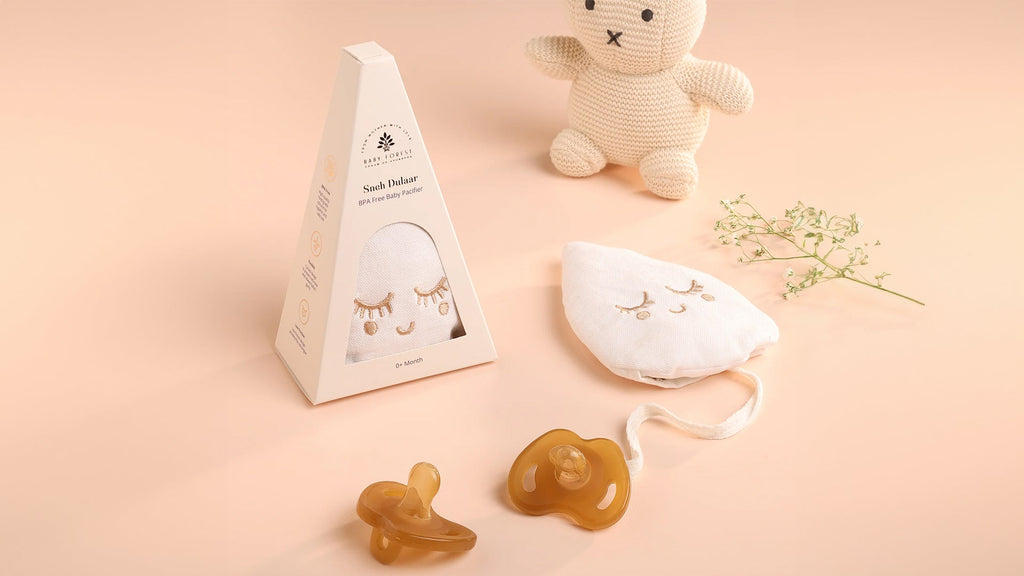
How to Choose the Right Pacifier for Your Baby's Comfort ...
A pacifier for baby can be incredibly helpful for parents, as it can calm a restless baby, encourage sleep, and lower the risk of Sudden Infant Death Syndrome (SIDS). But with so many options in the market, choosing the right pacifier for your baby's comfort and sleep isn't always easy. This blog will guide you through everything you need to know about selecting, using, and maintaining the right pacifier for your baby.
Understanding Baby Pacifiers
Pacifiers are small, nipple-like gadgets made specifically for babies' oral comfort. They come in various shapes and materials, but their primary function is to provide a soothing effect that mimics the comfort babies get from breastfeeding. A good pacifier can significantly calm your baby, helping them feel secure and relaxed, which promotes better sleep.
Selecting the Right Baby Pacifier
When choosing a pacifier, consider these important features:
Material
Look for pacifiers made from food-grade silicone that are durable, soft, and BPA-free to ensure your baby's safety.
Design
A low-friction, flexible design with a skin-like texture can mimic the feel of a mother's breast, making it more likely for your baby to accept the pacifier.
Safety Features
Ensure the pacifier has ventilation holes to prevent saliva buildup and skin irritation around your baby's mouth.
Shape
Orthodontic pacifiers are designed to prevent dental issues later on and support proper oral development. Choosing a pacifier for a baby that combines these elements will contribute to a safer, more comforting experience.
Safety and Hygiene Suggestions
You should always keep your baby's pacifier clean to preventing infections. Wash the baby pacifier with mild, soapy water before its first use and before each subsequent use. It is crucial to examine the pacifier nipple frequently for any indications of wear or harm, and if any defects are found, it should be replaced immediately. Additionally, it is essential to store the pacifier in a dry location, away from direct sunlight and heat sources. Remember, pacifiers should not be sterilized by boiling or subjected to intense heat, as this can degrade the material.
Tips for Introducing a Pacifier
Introducing a pacifier to your baby can be a helpful tool in soothing and comforting them, especially during the early months. However, the timing and method of introduction can play significant roles in how well your baby accepts the pacifier. Here are some tips to help you introduce a pacifier effectively:
Wait Until Breastfeeding is Established
If you are breastfeeding, it's crucial to wait until your baby is proficient at nursing, which typically takes about 3-4 weeks. Introducing a pacifier a little too early can lead to nipple confusion, where the baby might prefer the pacifier over the breast due to the difference in effort needed to extract milk.
Introduce During a Calm Time
You could consider offering the pacifier when your kid is quiet and not too hungry or weary. This can make it easier for your baby to explore the pacifier naturally without associating it with stress or urgent hunger.
Use it to Soothe, Not to Delay Feeding
Use the pacifier to soothe your baby, not as a replacement for feeding. Ensure that your baby is fully fed before offering the pacifier, as this helps prevent misinterpreting their cues for hunger.
Monitor for Any Signs of Discomfort
Monitor and check your baby for any signs of discomfort or rejection. If they consistently refuse the pacifier or seem distressed when using it, take a break and try again another time. Some babies may never take to a pacifier, and that's perfectly okay.
When choosing a pacifier for your baby, it's important to prioritize safety and comfort. By selecting a high-quality, well-designed pacifier and maintaining good hygiene practices, you can provide your baby with a source of comfort that also supports their health and development.
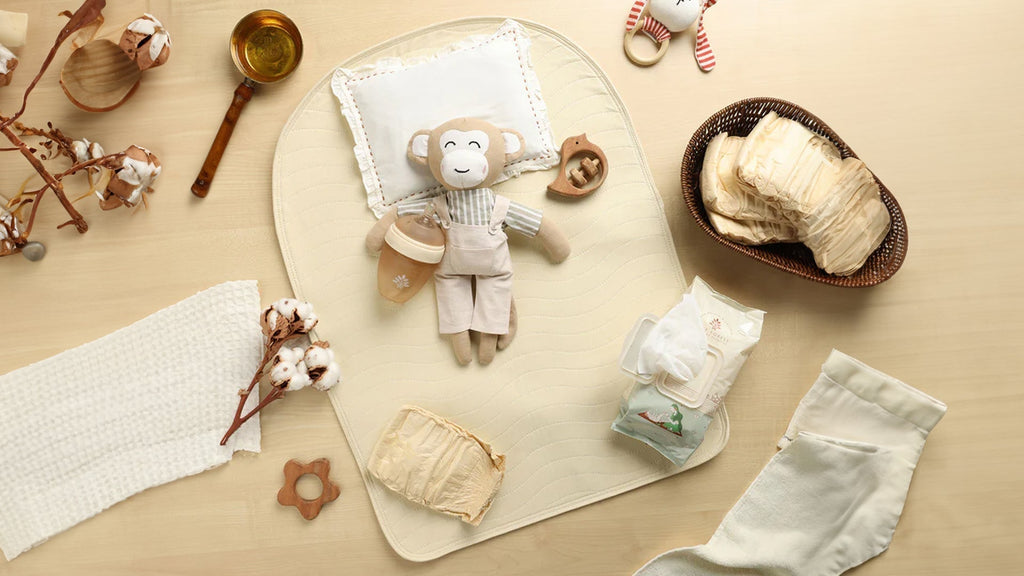
The Benefits of Using Dry Sheets in Diaper Changing and S...
As a parent, your baby's comfort and health are your top priorities. One simple yet effective way to ensure both during diaper changes and sleep time is by incorporating dry sheets into your routine.
What Are Dry Sheets?
Dry sheets, also known as absorbent sheets or waterproof bed protectors, are designed to keep moisture away from your baby's skin and bedding. Made from layers of materials, including absorbent and waterproof fabrics, these sheets are engineered to draw moisture away from the surface, keeping the baby dry and comfortable. Unlike traditional cloth or rubber sheets, modern dry sheets are breathable, soft, and safe for a baby's delicate skin, making them an essential part of baby care routines.
Let's dive into why these little sheets can make a big difference.
-
Keeping Baby Dry and Happy
Dry sheets are designed to provide a waterproof barrier that helps keep moisture away from your baby's skin. During diaper changes, a dry sheet can prevent any accidental leaks from reaching the changing table or any surface you're using. Placing a dry sheet under your little one at night can help manage any leaks, ensuring they stay dry and comfortable. This is crucial because a dry environment is essential for preventing diaper rashes, which are uncomfortable for your baby and stressful to manage.
Related Read - Is Your Baby Suffering From Diaper Rashes? Here Are The Best Ways to Treat Diaper Rashes
-
A Simple Solution for Better Sleep
As we know, babies are sensitive to discomfort, which can interrupt their precious sleep. A wet diaper or any moisture can be particularly disruptive. Using a dry sheet creates an additional layer of protection that helps maintain a dry sleeping environment. This can lead to longer, more peaceful sleep periods for your baby (and, let's face it, for you too!). Better sleep supports their overall development and ensures they're happier during their waking hours. -
Easy Cleanups
Let's talk practicality. Dry sheets are incredibly easy to use and change, making cleanups a breeze. For environmentally conscious parents, there are also reusable options available that can be washed and used again. -
Portable Convenience
Dry sheets are lightweight and portable, making them an essential item in your diaper bag. Whether you're visiting grandparents, enjoying a family outing, or travelling, they ensure that you can provide a clean and dry-changing surface anywhere. This flexibility can make diaper changes on the go less stressful for both you and your baby. -
Protecting Your Gear
Lastly, dry sheets are not just about keeping your baby dry; they also protect your changing tables, cribs, and car seats. Moisture can damage these surfaces over time or require extensive cleaning. Using dry sheets helps preserve the condition and longevity of your baby gear, saving you money and hassle in the long run.
Choosing the Right Dry Sheet
When selecting a dry sheet, consider the following factors to ensure you pick the best one for your baby:
- Material: Search for soft materials that are kind to the skin and devoid of toxic substances.
- Size: Choose a size that fits your baby's crib, cot, or bed snugly, covering the area effectively.
- Absorbency: Opt for sheets with high absorbency to keep moisture away from your baby's skin.
- Ease of Cleaning: Dry sheets that are machine washable and quick to dry will make your life easier.
Tips for Using Dry Sheets Effectively
- Regular Rotation: Have multiple dry sheets on hand to ensure you always have a clean one ready for use.
- Proper Placement: Ensure the dry sheet is laid out flat and securely in place to prevent bunching or shifting.
- Layering: For added protection, consider layering a dry sheet over a regular fitted sheet.
- Monitoring: Regularly check the dry sheet for dampness and change it immediately if it's wet to keep your baby dry and comfortable.
Beyond Dry Sheets: A Holistic Approach to Baby Comfort
While dry sheets are fantastic, they're just one piece of the puzzle. Here are additional tips to ensure your baby's ultimate comfort and well-being:
-
Choose the Right Diapers:
Opt for high-quality, absorbent diapers that fit well. The right diaper can make a significant difference in preventing leaks and discomfort. -
Regular Diaper Changes:
Keep your baby fresh and comfortable by changing diapers regularly, especially before bedtime or after meals. -
Diaper Rash Creams:
Have a good diaper rash cream on hand. Applying a barrier cream can provide an extra layer of protection against moisture.

-
Comfortable Sleep Environment:
Ensure your baby's sleeping area is quiet, dark, and at a comfortable temperature. Establishing a regular bedtime routine can enhance the quality of your sleep. -
Hydration and Diet:
For older babies, adequate hydration and a balanced diet can influence diaper habits, making them more predictable and manageable. -
Parental Self-Care:
Remember, a relaxed and happy parent can better attend to a baby's needs. Taking care of yourself is also taking care of your baby.
Dry sheets are a game-changer for new parents, offering unparalleled convenience, hygiene, and comfort for babies during diaper changes and sleep time. By choosing the right dry sheet and using it effectively, parents can ensure their little ones stay dry, comfortable, and happy. Remember, the journey of parenthood is filled with trials and errors, but with the right tools and a loving heart, every challenge becomes a stepping stone towards a fulfilling experience.
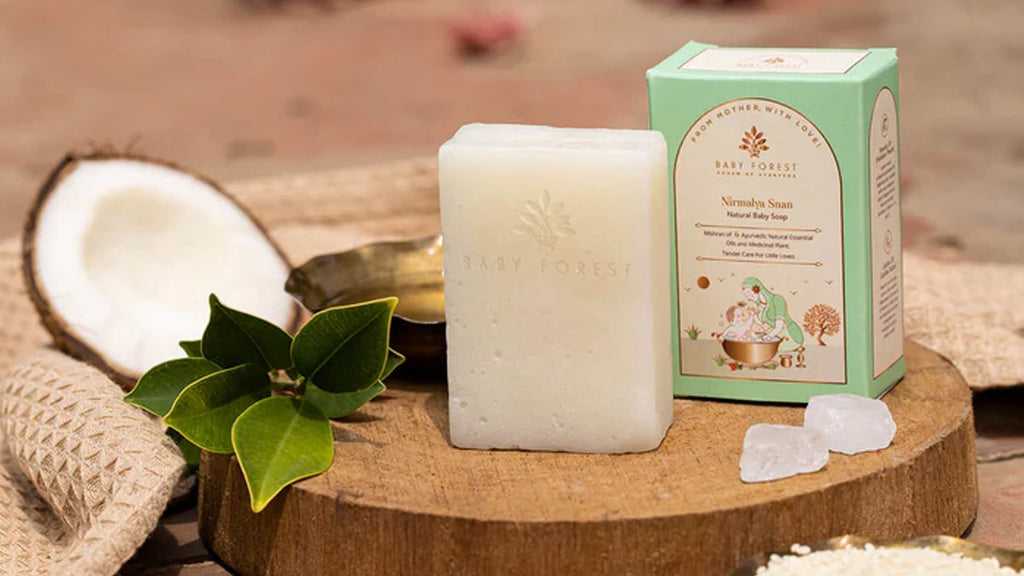
Natural Baby Soaps for Chemical-Free Bath Time
Because so many household goods include chemicals, it is essential that we put our children's health first when it comes to the purity of the products they use. Whether your kid is seven days, seven weeks, or seven months old, one thing remains constant: their sensitive and gentle skin. As a result, many bath and skin care products you use on yourself might cause rashes and irritation. Parents have become increasingly mindful of choosing baby products, which has led to a growing preference for natural baby products.
Bathing your baby is not just a task but a nurturing experience for their well-being. This blog will help you understand the benefits of choosing natural baby soaps and provide guidance on how to select the best soap for infants, guaranteeing a chemical-free bathing experience.
Why Choose Natural Baby Soaps?
Our skin is the biggest part of our body that shields our insides from the outside world. This is especially important for babies because their skin is significantly thinner than that of adults. This makes a baby's skin more delicate and also lets chemicals from normal soap get into the skin more easily. One study found that babies exposed to harsh soaps and shampoos are more likely to get skin problems like eczema and other skin irritations.
This is where natural baby soaps help with their organic ingredients, which makes it safer with no synthetic smells or harsh chemicals in them. These soaps only contain natural ingredients like coconut oil and shea butter. These natural ingredients are gentle and soft on a baby's skin.
How to Choose the Right Natural Baby Soap for Your Baby?
Choosing the right natural baby soap is crucial for your little one's delicate skin. With so many alternatives available, it might be difficult to choose the best one. However, focusing on specific qualities and ingredients can guide you in making a healthier choice for your baby. Here's how to ensure the soap you select is gentle, safe, and beneficial for your baby's bath time.
-
Paraben-Free
Parabens are preservatives used to prolong the shelf life of products, but they can disrupt hormone function, which is especially risky for babies. Opting for paraben-free baby soap ensures that your child is not exposed to these chemicals, making bath time safer.
-
Tear-Free
A tear-free formula is essential for baby soaps to prevent eye irritation during bath time. This means the soap is gentle enough that it won't sting your baby's sensitive eyes, making for a more pleasant bathing experience for both of you.
-
Natural Ingredients
Natural ingredients are the cornerstone of a good baby soap. Look at infant soaps with ingredients such as Jojoba Oil, Castor Oil, Coconut Oil, Sesame Oil, Rosehip Oil, and Aloe Vera. Chemical additives can be harsh on a baby's skin, leading to dryness and irritation. Natural soaps, on the other hand, use ingredients that are gentle and nourishing.
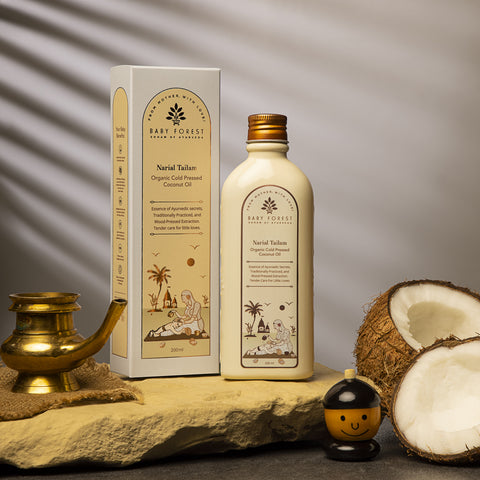
-
Vegan
Vegan baby soaps are made without any animal products or by-products, aligning with eco-friendly and cruelty-free practices. These soaps are also more likely to contain plant-based ingredients that are gentle and beneficial for the skin.
How to Use Baby Forest's Nirmalya Snan Natural Baby Soap?
To use the soap bar, simply wet your baby's skin with warm water, then gently rub the soap bar over their skin to create a soft lather. Massage the lather gently across their body with your hands or a soft washcloth. After ensuring their skin is thoroughly cleansed, rinse off the lather with plenty of water, making sure no soap residue remains.
When choosing baby care products, it's important to consider your child's well-being and the environment. Natural baby soaps are a great option, as they are gentle on your baby's skin and free from harsh chemicals. This helps create a safe and enjoyable bathtime experience for your little one. By choosing natural products, you're also contributing to a more sustainable world, reducing your exposure to harmful chemicals. This is a worthwhile investment in your child's health and the future of our planet.

How to Pick Safe Essential Baby Care Products
Navigating the vast world of baby care products can be overwhelming for new parents. You want the best for your little one, ensuring every product, from their lotion to their toys, is safe, gentle, and beneficial for their development. This guide aims to simplify the whole process for you, providing you with the knowledge to choose the best baby products, focusing on safety, natural ingredients, and the well-being of your newborn.
Understanding Baby Care Product Safety
The safety of baby care products lies in their ingredients and materials. Go for products that are free from harmful chemicals and dyes, which can irritate delicate skin or cause allergic reactions. Look for certifications and labels that guarantee products are tested and safe for babies. Reading reviews and researching baby products online can also offer insights into their safety and efficacy.
Essentials for a Safe Nursery
Creating a safe nursery goes beyond aesthetics. It includes choosing organic bedding, hypoallergenic mattresses, and non-toxic paints. Ensure that all furniture is sturdy and meets safety standards. Air purifiers can also contribute to creating a clean, safe environment by reducing potential airborne irritants.
Safe Skincare and Bathing Practices
Babies' skin is incredibly sensitive, requiring products that moisturize and protect without causing harm. Natural and ayurvedic baby skincare products, such as baby face cream and baby lotion made with ingredients such as chamomile, aloe vera, and coconut oil, offer gentle hydration. For bathing, opt for mild, tear-free baby shampoo and baby body wash that cleans without stripping natural oils. Always test products on a small skin area first to check for any reactions.

Choosing Safe Clothing and Diapers
Selecting clothing and diapers for your baby involves more than just comfort and design. Choose organic cotton or bamboo fabrics that are soft, breathable, and free from harmful chemicals. When it comes to diapers, consider cloth options or chemical-free disposables that offer high absorbency without risking diaper rash or exposure to irritants.

Safe Feeding Practices
Feeding your baby safely is paramount. Glass feeding bottles offer a reliable alternative to plastic, mitigating the risk of BPA exposure. When your baby progresses to solids, bamboo baby feeding bowls provide durable and non-toxic choices. Bamboo bowls are especially favoured for their eco-friendly and biodegradable qualities, making them a safe choice for your baby and the environment. Remember to sterilize feeding items thoroughly to ensure they remain hygienic for your baby's use.

Safe Playtime Essentials
Toys play a significant role in your baby's development, but choosing safe playtime essentials is key. Look for toys made from natural materials like organic cotton crochet toys or food-grade silicone. These materials are not only safer but are also environment friendly. Stacking toys, soft books, and sensory balls are excellent for stimulating your baby's senses without the worry of harmful substances.
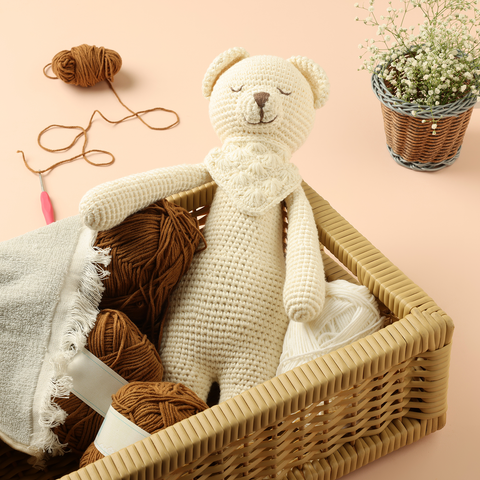
Choosing safe, essential baby care products is a journey filled with love and care. By prioritizing products that are natural, free from harmful chemicals, and designed with your baby's health in mind, you can create a nurturing environment for your little one to grow and thrive. Whether you're purchasing baby skin care products, setting up the nursery, or selecting toys, remember that simplicity and safety go hand in hand. With the correct information and a conscious attitude, you can confidently explore the vast choices of newborn baby products, assuring that you only choose the best for your precious bundle of joy.
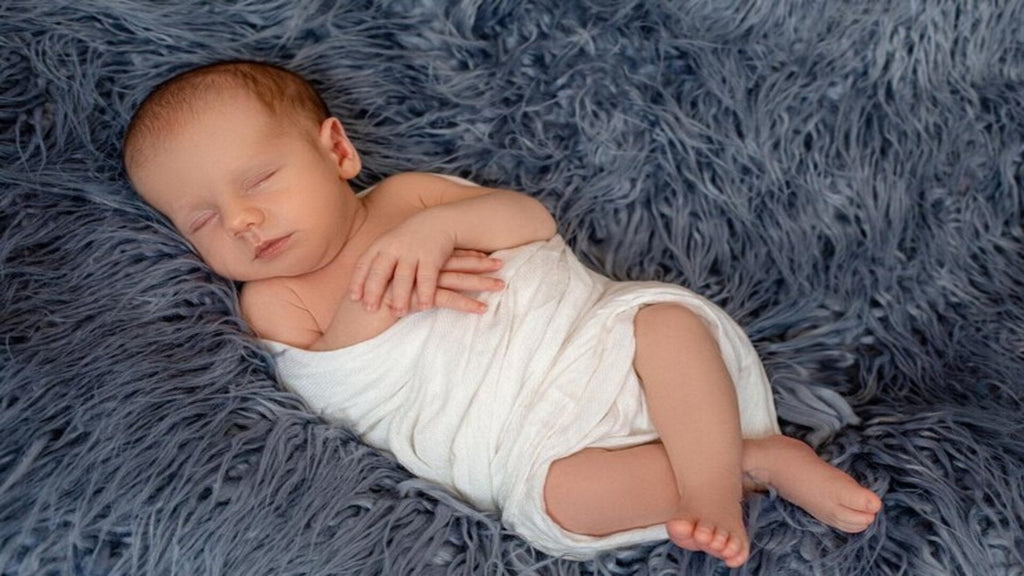
The Essential Guide to Perfect Swaddling: Techniques and ...
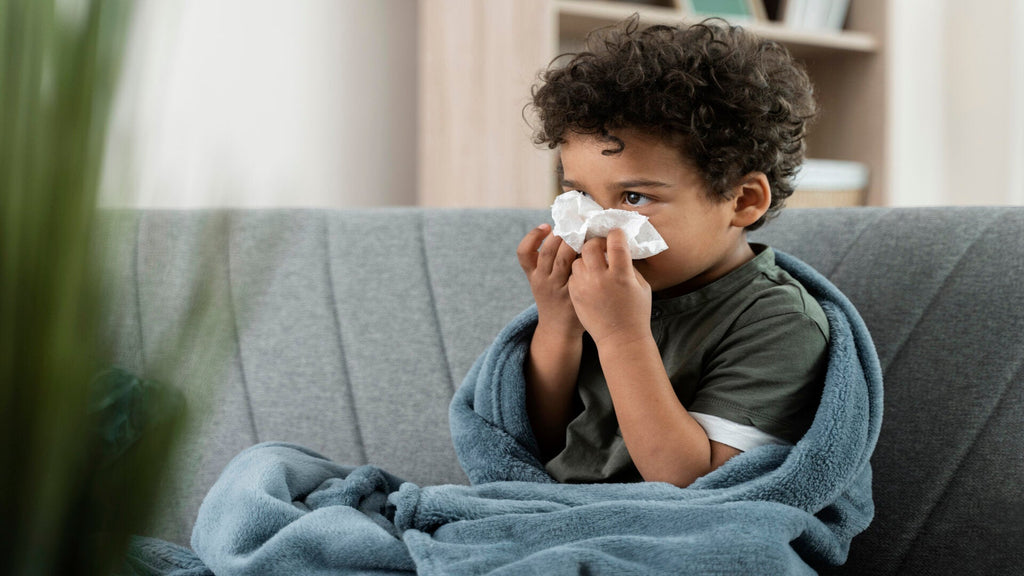
5 Ways for Managing and Soothing Your Baby's Runny Nose
Believe it or not, a runny nose can be a good thing. It's the body's natural mechanism for getting rid of germs. However, when your precious little one is grappling with too much mucus, it can lead to a stuffy head, making it challenging for them to eat, sleep, and breathe comfortably. Dealing with an infant's stuffy nose can be a concern for parents. Fortunately, a few home treatments can bring relief and make your baby comfortable again. In this article, we'll explore five effective ways to manage and soothe your baby's runny nose.
Understanding Baby Nasal Congestion
Causes of Nasal Congestion in Babies
Before diving into remedies, it's crucial to understand the root causes of nasal congestion in infants. Common culprits include viral infections, such as the common cold, allergies, and exposure to irritants like dust or smoke. The nasal passages of babies are narrow, making them more susceptible to blockages. Identifying the cause can help tailor the treatment for optimal results.
Premature babies, with their weaker immune systems, may face additional challenges in warding off infections that can contribute to nasal congestion. Furthermore, infants who have never been breastfed may be more prone to cough and congestion, as breast milk provides essential antibodies and nutrients that support a baby's immune system and respiratory health.
Recognizing Signs of Nasal Congestion
Recognizing the signs of nasal congestion is the first step in addressing the issue. Watch for symptoms like excessive sneezing, difficulty breathing, and a persistent runny nose. Babies may also become fussy, have trouble sleeping, or struggle with feeding due to nasal congestion. Additionally, keep an eye out for the emergence of fever and snoring, which can be indicative of more severe congestion and may require prompt attention. Being attentive to these signs allows for timely intervention.
Safe Methods for Clearing a Baby's Stuffy Nose
-
Nasal Saline Drops
Nasal saline drops are a gentle and effective way to alleviate nasal congestion in babies. These drops help to loosen mucus, making it easier for your little one to breathe. It's easy to administer saline drops to your baby: just tilt their head back a little, inject a few drops into each nostril, and then use a bulb syringe to suction away the mucus that has been released. -
Baby Vapor Rub
Baby vapour rubs are formulated with mild ingredients suitable for infants. Applying a small amount to your baby's chest or back, especially during sleep time, can provide relief by releasing soothing vapours. Komal Shwaas Baby Vapour Rub is a 100% natural baby vapour rub made with the healing powers of plant based Ayurvedic ingredients such as Aloe Vera Oil, Rosemary Oil, Eucalyptus Oil, Lavender Oil, Vitamin E and more. These ingredients not only effectively treat sore throats and promotes better sleep among babies but also offer additional benefits. Aloe Vera Oil soothes and moisturizes the skin, while Rosemary Oil and Eucalyptus Oil help clear breathing pathways and Lavender Oil promotes relaxation. Be sure to select baby care products that are made especially for babies, as adult formulas may contain substances that are too harsh for a baby's sensitive skin. The age group for using Baby Forest’s ayurvedic baby vapour rub is 3 months and older.

-
Steam Therapy
Steam therapy is a natural remedy that helps relieve nasal congestion by loosening mucus and making it easier for your baby to breathe. Run a hot shower and spend some time in the bathroom with your infant to create a steamy atmosphere. Ensure the water temperature is comfortable, and never leave your baby unattended near hot water. -
Elevating the Head
Elevating your baby's head while sleeping can prevent mucus from pooling in the nasal passages, reducing congestion. To create a slight inclination, place a small pillow or rolled-up blanket underneath the crib mattress. This simple adjustment promotes better airflow and aids in the natural drainage of nasal secretions.
Home Remedies and Precautions
-
Hydration
Ensuring your baby stays well-hydrated is essential in managing nasal congestion. Offer frequent feeds, whether through breastfeeding or formula, as the extra fluids can help thin mucus. If your baby has started solids, consider incorporating hydrating foods like soups and purees into their diet. -
Warm Compress
A warm compress can provide relief by soothing the irritated skin around your baby's nose. For a few minutes, gently apply a soft cloth dipped in warm water on your baby's face after wringing off any extra water. This can help alleviate discomfort and make breathing more comfortable. -
Avoiding Irritants
Identifying and minimizing exposure to irritants is crucial for preventing and managing nasal congestion. Keep your baby's environment smoke-free, limit exposure to strong odours or perfumes, and ensure the living space is free from dust and allergens.
When to Seek Professional Help
While most cases of infant nasal congestion can be managed at home, there are instances where professional intervention is necessary. If your baby's symptoms persist or worsen, or if you notice signs of respiratory distress, it's essential to consult with a pediatrician promptly. Timely medical attention can prevent complications and provide peace of mind for concerned parents.
Remember to maintain a hygienic and irritant-free environment, and always consult with a healthcare professional if you have concerns about your baby's nasal congestion. These simple strategies will help your baby breathe easily and enjoy a healthy start to life.



